Äîêóìåíòàöèÿ è îïèñàíèÿ www.docs.chipfind.ru
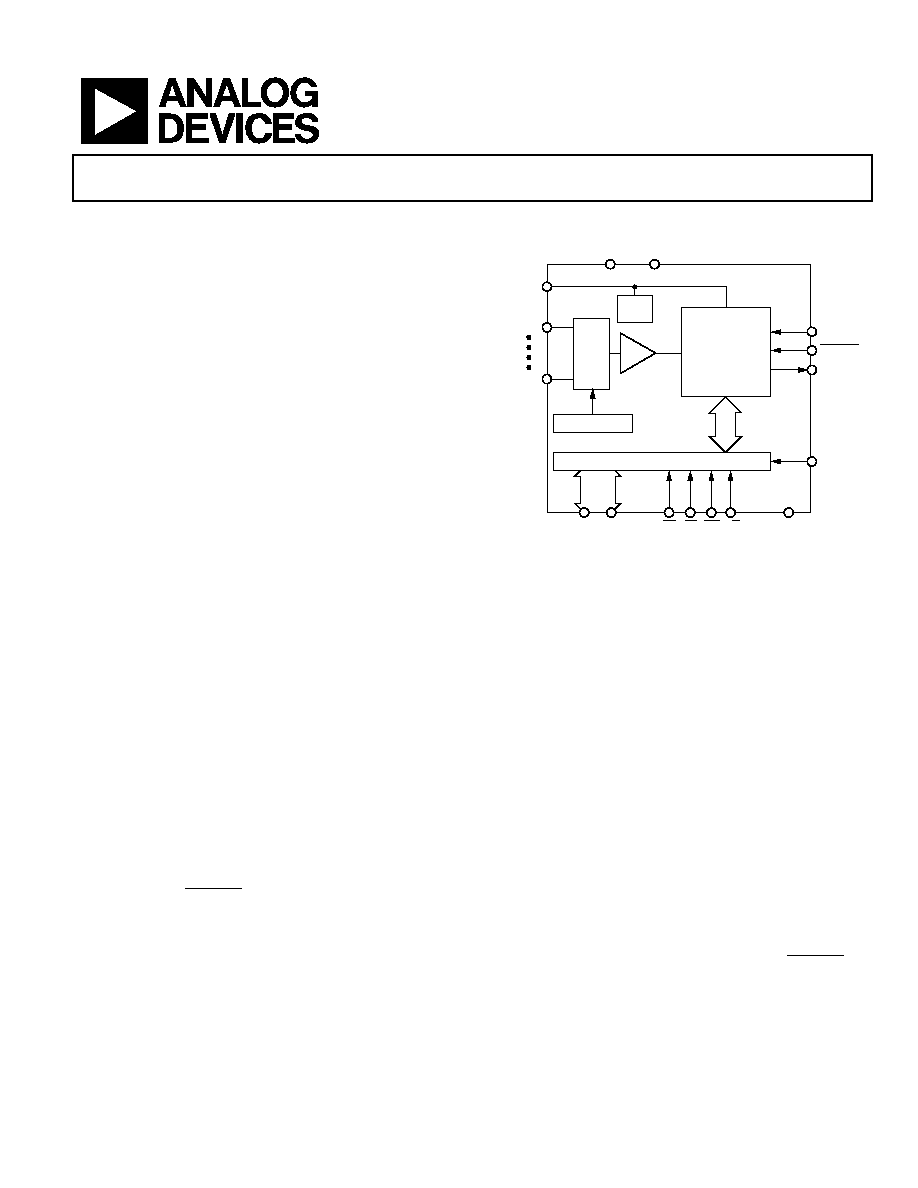
4-Channel, 1.5 MSPS, 12-Bit and 10-Bit
Parallel ADCs with a Sequencer
Preliminary Technical Data
AD7933/AD7934
FEATURES
Fast throughput rate: 1.5 MSPS
Specified for V
DD
of 2.7 V to 5.25 V
Low power
8 mW max at 1.5 MSPS with 3 V supplies
16 mW max at 1.5 MSPS with 5 V supplies
4 analog input channels with a sequencer
Software configurable analog inputs
4-channel single-ended inputs
2-channel fully differential inputs
2-channel pseudo-differential inputs
Accurate on-chip 2.5 V reference
Wide input bandwidth
70 dB SNR at 50 kHz input frequency
No pipeline delays
High speed parallel interface--word/byte modes
Full shutdown mode: 1 µA max
28 lead TSSOP package
FUNCTIONAL BLOCK DIAGRAM
03713-0-001
V
IN
3
T/H
PARALLEL INTERFACE/CONTROL REGISTER
SEQUENCER
12-/10-BIT
SAR ADC
AND
CONTROL
I/P
MUX
2.5V
VREF
DB0 DB11
V
DRIVE
V
DD
AD7933/AD7934
V
IN
0
AGND
V
REFIN/
V
REFOUT
CLKIN
BUSY
CONVST
CS
DGND
RD WR W/B
Figure 1.
GENERAL DESCRIPTION
The AD7933/AD7934 are 12-bit and 10-bit, high speed, low
power, successive approximation (SAR) ADCs. The parts
operate from a single 2.7 V to 5.25 V power supply and feature
throughput rates to 1.5 MSPS. The parts contain a low noise,
wide bandwidth, differential track-and-hold amplifier that can
handle input frequencies up to 20 MHz.
The AD7933/AD7934 feature 4 analog input channels with a
channel sequencer to allow a consecutive sequence of channels
to be converted on. These parts can accept either single-ended,
fully differential, or pseudo-differential analog inputs.
The conversion process and data acquisition are controlled
using standard control inputs, which allows for easy interfacing
to microprocessors and DSPs. The input signal is sampled on
the falling edge of CONVST and the conversion is also initiated
at this point.
The AD7933/AD7934 has an accurate on-chip 2.5 V reference
that can be used as the reference source for the analog-to-digital
conversion. Alternatively, this pin can be overdriven to provide
an external reference.
These parts use advanced design techniques to achieve very low
power dissipation at high throughput rates. They also feature
flexible power management options. An on-chip control register
allows the user to set up different operating conditions,
including analog input range and configuration, output coding,
power management, and channel sequencing.
PRODUCT HIGHLIGHTS
1. High throughput with low power consumption.
2. Four analog inputs with a channel sequencer.
3. Accurate on-chip 2.5 V reference.
4. Software configurable analog inputs. Single-ended, pseudo-
differential, or fully differential analog inputs that are
software selectable.
5. Single-supply operation with V
DRIVE
function. The V
DRIVE
function allows the parallel interface to connect directly to
3 V, or 5 V processor systems independent of V
DD
.
6. No pipeline delay.
7. Accurate control of the sampling instant via a CONVST
input and once off conversion control.
PrG
Information furnished by Analog Devices is believed to be accurate and reliable.
However, no responsibility is assumed by Analog Devices for its use, nor for any
infringements of patents or other rights of third parties that may result from its use.
Specifications subject to change without notice. No license is granted by implication
or otherwise under any patent or patent rights of Analog Devices. Trademarks and
registered trademarks are the property of their respective owners.
One Technology Way, P.O. Box 9106, Norwood, MA 02062-9106, U.S.A.
Tel: 781.329.4700
www.analog.com
Fax: 781.326.8703
© 2004 Analog Devices, Inc. All rights reserved.
Rev.

AD7933/AD7934
Preliminary Technical Data
TABLE OF CONTENTS
AD7933--Specifications.................................................................. 3
AD7934--Specifications.................................................................. 5
Timing Specifications....................................................................... 7
Absolute Maximum Ratings............................................................ 8
ESD Caution.................................................................................. 8
Pin Configuration and Function Descriptions............................. 9
Terminology .................................................................................... 11
Typical Performance Characteristics ........................................... 13
Control Register.......................................................................... 16
Sequencer Operation ................................................................. 17
Circuit Information ........................................................................ 18
Converter Operation.................................................................. 18
ADC Transfer Function............................................................. 18
Typical Connection Diagram ................................................... 19
Analog Input Structure.............................................................. 19
Analog Inputs.............................................................................. 20
Analog Input Selection .............................................................. 22
Reference Section ....................................................................... 22
Parallel Interface......................................................................... 24
Power Modes of Operation....................................................... 27
Power vs. Throughput Rate....................................................... 28
Microprocessor Interfacing....................................................... 28
Application Hints ........................................................................... 30
Grounding and Layout .............................................................. 30
Evaluating the AD7933/AD7934 Performance ...................... 30
Outline Dimensions ....................................................................... 31
Ordering Guide .......................................................................... 31
REVISION HISTORY
8/04--Revision PrG: Preliminary Version
Rev. PrG | Page 2 of 32
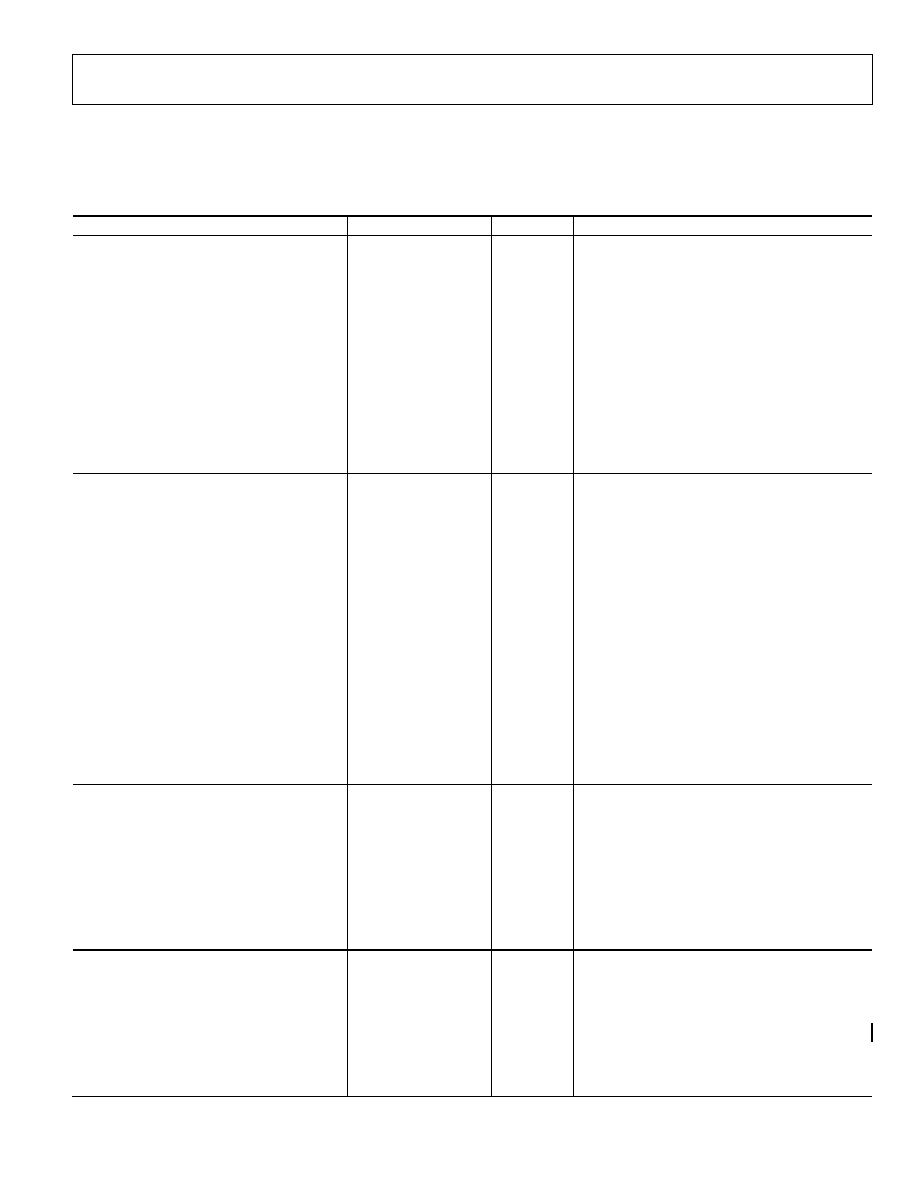
Preliminary Technical Data
AD7933/AD7934
AD7933--SPECIFICATIONS
V
DD
= V
DRIVE
=2.7 V to 5.25 V, Internal/External V
REF
= 2.5 V, unless otherwise noted, F
CLKIN
= 24 MHz, F
SAMPLE
= 1.5 MSPS; T
A
= T
MIN
to
T
MAX
, unless otherwise noted.
Table 1.
Parameter B
Version
1
Unit
Test Conditions/Comments
DYNAMIC PERFORMANCE
F
IN
= 50 kHz sine wave
Signal-to-Noise + Distortion (SINAD)
2
60
dB min
Signal-to-Noise Ratio (SNR)
2
60
dB min
Total Harmonic Distortion (THD)
2
-73
dB max
Peak Harmonic or Spurious Noise (SFDR)
2
-73
dB max
Intermodulation Distortion (IMD)
2
fa = 40.1 kHz, fb = 51.5 kHz
Second-Order Terms
-75
dB typ
Third-Order Terms
-75
dB typ
Channel-to-Channel Isolation
-75
dB typ
Aperture Delay
2
5
ns typ
Aperture Jitter
2
50
ps typ
Full Power Bandwidth
2, 3
20
MHz typ
@ 3 dB
2.5
MHz typ
@ 0.1 dB
DC ACCURACY
Resolution
10
Bits
Integral Nonlinearity
2
±0.5
LSB max
Differential Nonlinearity
2
±0.5
LSB max
Guaranteed no missed codes to 10 bits
Total Unadjusted Error
TBD
LSB max
Single-Ended and Pseudo Differential Input
Straight binary output coding
Offset Error
2
±4.5
LSB max
Offset Error Match
2
±0.5
LSB max
Gain Error
2
±2
LSB max
Gain Error Match
2
±0.6
LSB max
Fully Differential Input
Twos complement output coding offset
Positive Gain Error
2
±2
LSB max
Positive Gain Error Match
2
±0.6
LSB max
Zero-Code Error
2
±3
LSB max
Zero-Code Error Match
2
±1
LSB max
Negative Gain Error
2
±2
LSB max
Negative Gain Error Match
2
±0.6
LSB max
ANALOG INPUT
Single-Ended Input Range
0 to V
REF
or 0 to 2 × V
REF
V
Depending on RANGE bit setting
Pseudo-Differential Input Range: V
IN+
0 to V
REF
or 2 × V
REF
V
Depending on RANGE bit setting
V
IN-
-0.1 to +0.4
V
Fully Differential Input Range: V
IN+
and V
IN-
V
CM
± V
REF
/2 V V
CM
= common-mode voltage
4
= V
REF
/2
V
IN+
and V
IN-
V
CM
± V
REF
V
V
CM
= V
REF
, V
IN+
or V
IN-
must remain within GND/V
DD
DC Leakage Current
5
±1
µA max
Input Capacitance
45
pF typ
When in track
10
pF typ
When in hold
REFERENCE INPUT/OUTPUT
V
REF
Input Voltage
6
2.5
V
±1% specified performance
DC Leakage Current
5
±1
µA max
V
REF
Input Impedance
10
k
V
REFOUT
Output Voltage
2.5
V
±0.1% @ 25°C
V
REFOUT
Temperature Coefficient
15
ppm/°C typ
V
REF
Noise
10
µV typ
0.1 Hz to 10 Hz bandwidth
130
µV typ
0.1 Hz to 1 MHz bandwidth
Rev. PrG | Page 3 of 32
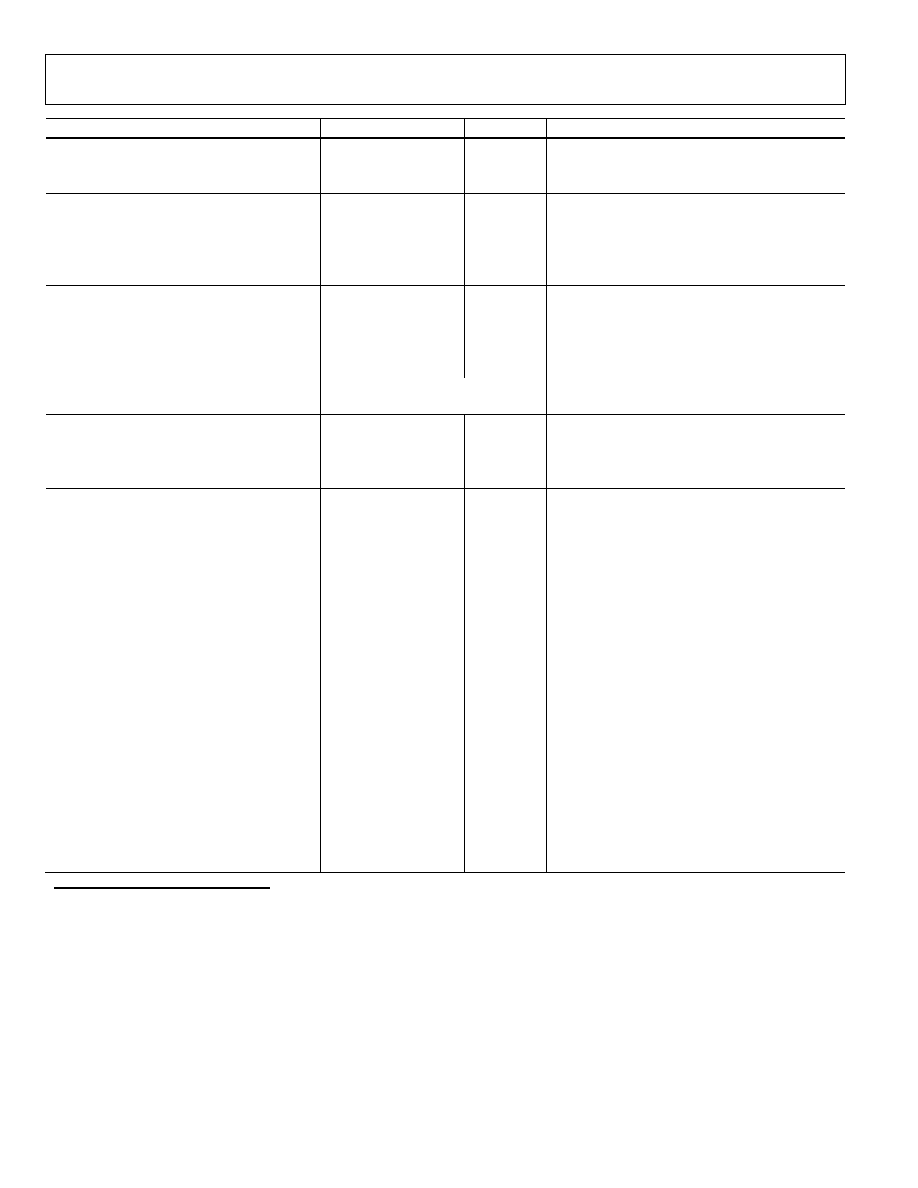
AD7933/AD7934
Preliminary Technical Data
Parameter B
Version
1
Unit
Test Conditions/Comments
V
REF
Output Impedance
10
typ
V
REF
Input Capacitance
15
pF typ
When in track
25
pF typ
When in hold
LOGIC INPUTS
Input High Voltage, V
INH
2.4
V min
Input Low Voltage, V
INL
0.8 V
max
Input Current, I
IN
±1
µA max
Typically 10 nA, V
IN
= 0 V or V
DRIVE
Input Capacitance, C
IN
5
10
pF max
LOGIC OUTPUTS
Output High Voltage, V
OH
2.4
V min
I
SOURCE
= 200 µA;
Output Low Voltage, V
OL
0.4
V max
I
SINK
= 200 µA
Floating-State Leakage Current
±10
µA max
Floating-State Output Capacitance
5
10
pF max
Output Coding
CODING bit = 0
Straight (Natural) Binary
Twos Complement
CODING bit = 1
CONVERSION RATE
Conversion Time
t
2
+ 13
tclk
+ t
20
ns
Track-and-Hold Acquisition Time
135
ns max
Full scale step input
Throughput Rate
1.5
MSPS max
POWER REQUIREMENTS
V
DD
2.7/5.25
V min/max
V
DRIVE
2.7 /5.25
V min/max
I
DD
7
Digital I/Ps = 0 V or V
DRIVE
Normal Mode(Static)
0.5
mA typ
V
DD
= 2.7 V to 5.25 V, SCLK on or off
Normal Mode (Operational)
3.2
mA max
V
DD
= 4.75 V to 5.25 V
2.6
mA max
V
DD
= 2.7 V to 3.6 V
Auto StandBy Mode
1.55
mA typ
F
SAMPLE
= 250 kSPS
90
µA max
(Static)
Auto Shutdown Mode
1
mA typ
F
SAMPLE
= 250 kSPS
1
µA max
(Static)
Full Shutdown Mode
1
µA max
SCLK on or off
Power Dissipation
Normal Mode (Operational)
16
mW max
V
DD
= 5 V
8
mW max
V
DD
= 3 V
Auto Standby Mode (Static)
450
µW max
V
DD
= 5 V
270
µW max
V
DD
= 3 V
Auto Shutdown Mode (Static)
5
µW max
V
DD
= 5 V
3
µW max
V
DD
= 3 V
Full Shutdown Mode
5
µW max
V
DD
= 5 V
3
µW max
V
DD
= 3 V
1
Temperature range is as follows: B Versions: -40°C to +85°C.
2
See Terminology section.
3
Analog inputs with slew rates exceeding 27 V/µs (full-scale input sine wave >3.5 MHz) within the acquisition time may cause an incorrect conversion result to be
returned by the converter.
4
For full common-mode range see
5
Sample tested during initial release to ensure compliance.
6
This device is operational with an external reference in the range 0.1 V to 3.5 V differential mode and 0.1 V to V
DD
in pseudo-differential and single-ended modes.
7
Measured with a midscale dc input.
Rev. PrG | Page 4 of 32
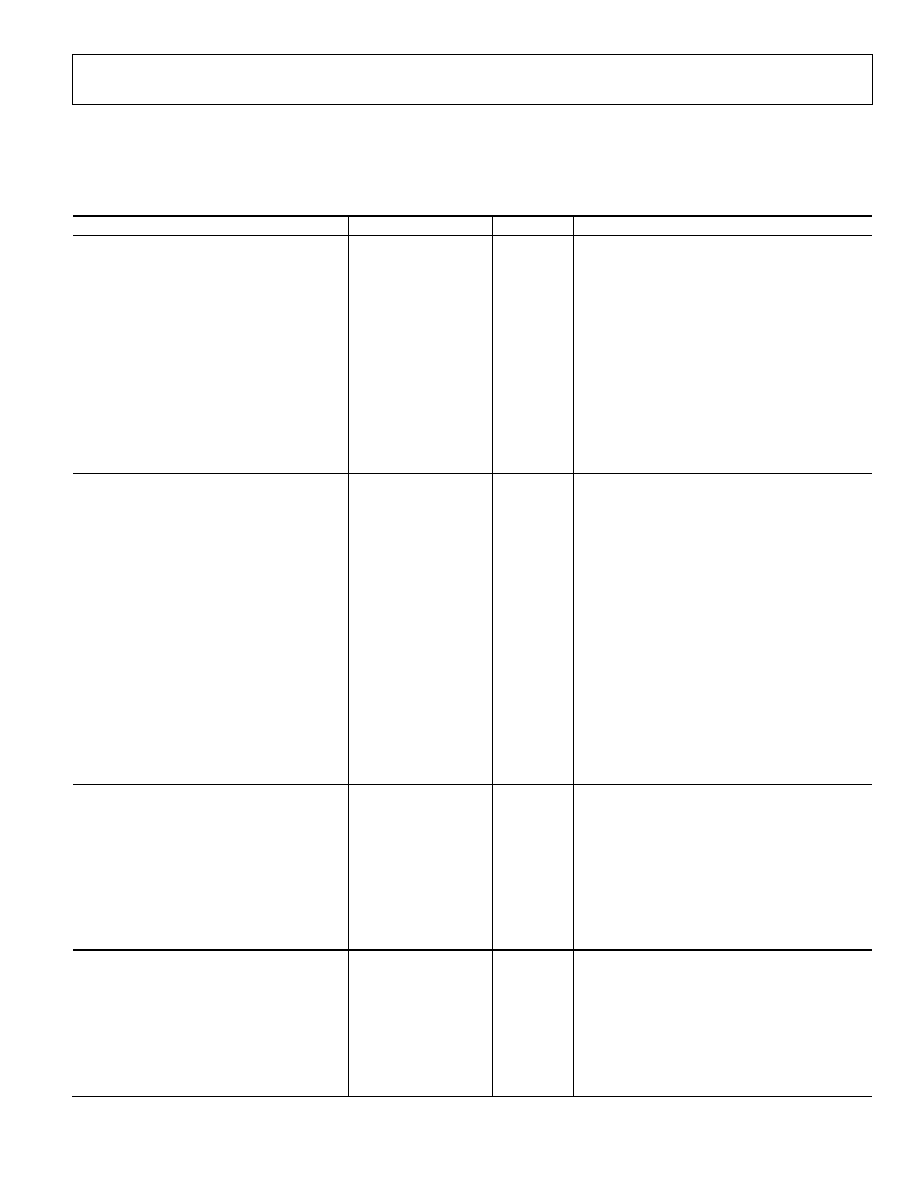
Preliminary Technical Data
AD7933/AD7934
AD7934--SPECIFICATIONS
V
DD
= V
DRIVE
= 2.7 V to 5.25 V, Internal/External V
REF
= 2.5 V, unless otherwise noted, F
CLKIN
= 24 MHz, F
SAMPLE
= 1.5 MSPS; T
A
= T
MIN
to
T
MAX
, unless otherwise noted.
Table 2.
Parameter
B Version
1
Unit
Test Conditions/Comments
DYNAMIC PERFORMANCE
F
IN
= 50 kHz sine wave
Signal-to-Noise + Distortion (SINAD)
2
70
dB min
Signal-to-Noise Ratio (SNR)
2
70
dB min
Total Harmonic Distortion (THD)
2
-75
dB max
-80 dB typ
Peak Harmonic or Spurious Noise (SFDR)
2
-75
dB max
-82 dB typ
Intermodulation Distortion (IMD)
2
fa = 40.1 kHz, fb = 51.5 kHz
Second-Order Terms
-85
dB typ
Third-Order Terms
-85
dB typ
Channel-to-Channel Isolation
-85
dB typ
Aperture Delay
2
5
ns typ
Aperture Jitter
2
50
ps typ
Full Power Bandwidth
2, 3
20
MHz typ
@ 3 dB
2.5
MHz typ
@ 0.1 dB
DC ACCURACY
Resolution
12
Bits
Integral Nonlinearity
2
±1
LSB max
Differential Nonlinearity
2
±0.95
LSB max
Guaranteed no missed codes to 12 bits
Total Unadjusted Error
TBD
LSB max
Single-Ended and Pseudo-Differential Input
Straight binary output coding
Offset Error
2
±4.5
LSB max
Offset Error Match
2
±0.5
LSB max
Gain Error
2
±2
LSB max
Gain Error Match
2
±0.6
LSB max
Fully Differential Input
Twos complement output coding
Positive Gain Error
2
±2
LSB max
Positive Gain Error Match
2
±0.6
LSB max
Zero-Code Error
2
±3
LSB max
Zero-Code Error Match
2
±1
LSB max
Negative Gain Error
2
±2
LSB max
Negative Gain Error Match
2
±0.6
LSB max
ANALOG INPUT
Single-Ended Input Range
0 to V
REF
or 0 to 2 × V
REF
V
Depending on RANGE bit setting
Pseudo-Differential Input Range: V
IN+
0 to V
REF
or 2 × V
REF
V
Depending on RANGE bit setting
V
IN-
-0.1 to +0.4
V
Fully Differential Input Range: V
IN+
and V
IN-
V
CM
± V
REF
/2 V V
CM
= common-mode voltage
4
= V
REF
/2
V
IN+
and V
IN-
V
CM
± V
REF
V
V
CM
= V
REF
, V
IN+
or V
IN-
must remain within GND/V
DD
DC Leakage Current
5
±1
µA max
Input Capacitance
45
pF typ
When in track
10
pF typ
When in hold
REFERENCE INPUT/OUTPUT
V
REF
Input Voltage
6
2.5
V
±1% specified performance
DC Leakage Current
±1
µA max
V
REF
Input Impedance
10
k typ
V
REFOUT
Output Voltage
2.5
V
±0.1% @ 25°C
V
REFOUT
Temperature Coefficient
15
ppm/°C typ
V
REF
Noise
10
µV typ
0.1 Hz to 10 Hz bandwidth
130
µV typ
0.1 Hz to 1 MHz bandwidth
Rev. PrG | Page 5 of 32
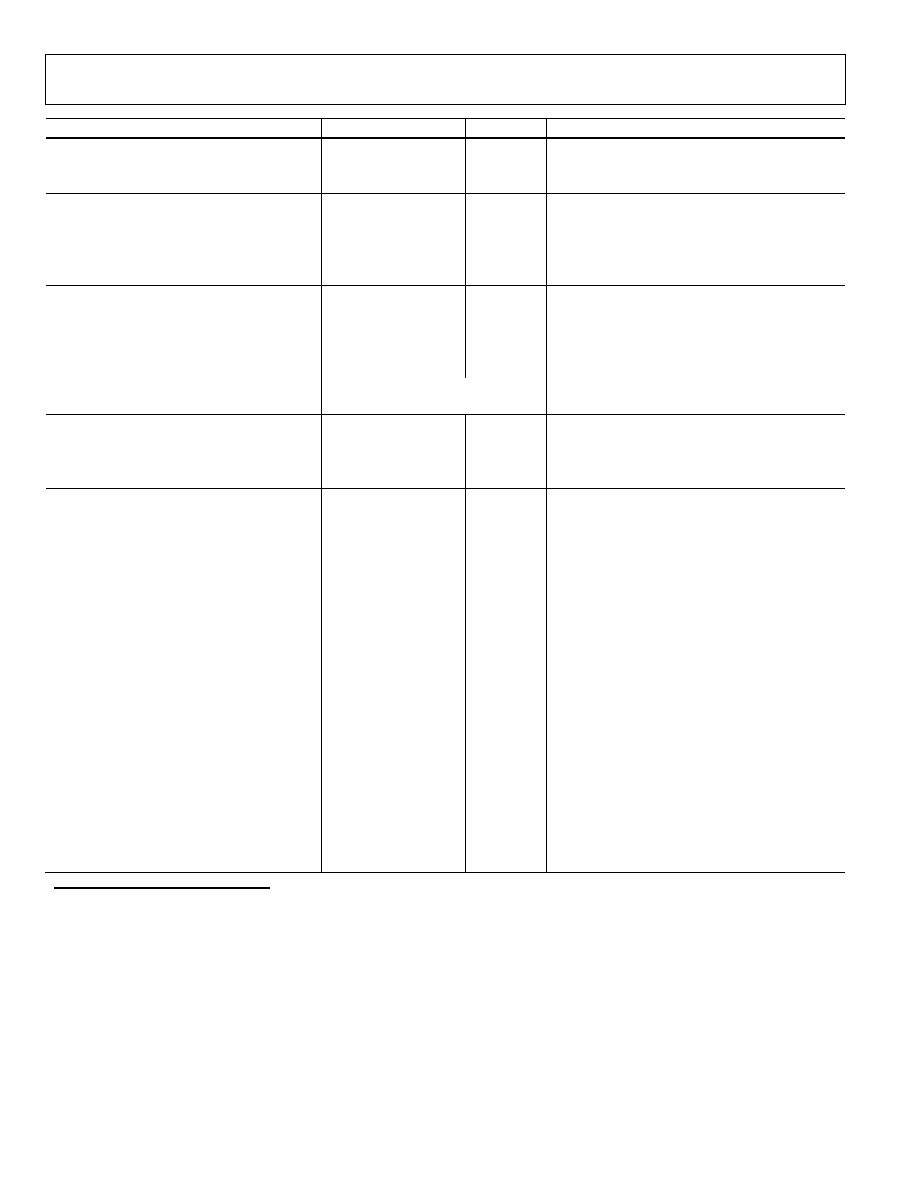
AD7933/AD7934
Preliminary Technical Data
Parameter
B Version
1
Unit
Test Conditions/Comments
V
REF
Output Impedance
10
typ
V
REF
Input Capacitance
15
pF typ
When in track-and-hold
25
pF typ
When in track-and-hold
LOGIC INPUTS
Input High Voltage, V
INH
2.4
V min
Input Low Voltage, V
INL
0.8
V
max
Input Current, I
IN
±1
µA max
Typically 10 nA, V
IN
= 0 V or V
DRIVE
Input Capacitance, C
IN
5
10 pF
max
LOGIC OUTPUTS
Output High Voltage, V
OH
2.4
V min
I
SOURCE
= 200 µA;
Output Low Voltage, V
OL
0.4
V max
I
SINK
= 200 µA
Floating-State Leakage Current
±10
µA max
Floating-State Output Capacitance
5
10
pF max
Output Coding
CODING bit = 0
Straight (Natural) Binary
Twos Complement
CODING bit = 1
CONVERSION RATE
Conversion Time
t
2
+ 13
tclk
+ t
20
ns
Track-and-Hold Acquisition Time
135
ns max
Full scale step input
Throughput Rate
1.5
MSPS max
POWER REQUIREMENTS
V
DD
2.7/5.25
V min/max
V
DRIVE
2.7 /5.25
V min/max
I
DD
7
Digital I/Ps = 0 V or V
DRIVE
Normal Mode(Static)
0.5
mA typ
V
DD
= 2.7 V to 5.25 V, SCLK on or off
Normal Mode (Operational)
3.2
mA max
V
DD
= 4.75 V to 5.25 V
2.6
mA max
V
DD
= 2.7 V to 3.6 V
Auto StandBy Mode
1.55
mA typ
F
SAMPLE
= 250 kSPS
90
µA max
(Static)
Auto Shutdown Mode
1
mA typ
F
SAMPLE
= 250 kSPS
1
µA max
(Static)
Full Shutdown Mode
1
µA max
SCLK on or off
Power Dissipation
Normal Mode (Operational)
16
mW max
V
DD
= 5 V
8
mW max
V
DD
= 3 V
Auto Standby Mode (Static)
450
µW max
V
DD
= 5 V
270
µW max
V
DD
= 3 V
Auto Shutdown Mode (Static)
5
µW max
V
DD
= 5 V
3
µW max
V
DD
= 3 V
Full Shutdown Mode
5
µW max
V
DD
= 5 V
3
µW max
V
DD
= 3 V
1
Temperature ranges is as follows: B Versions: -40°C to +85°C.
2
See Terminology section.
3
Analog inputs with slew rates exceeding 27 V/µs (full-scale input sine wave > 3.5 MHz) within the acquisition time may cause an incorrect result to be returned by the
converter.
4
For full common mode range see
5
Sample tested during initial release to ensure compliance.
6
This device is operational with an external reference in the range 0.1 V to 3.5 V in differential mode and 0.1 V to V
DD
in pseudo-differential and single-ended modes.
See the Reference Section for more information.
7
Measured with a midscale dc input.
Rev. PrG | Page 6 of 32
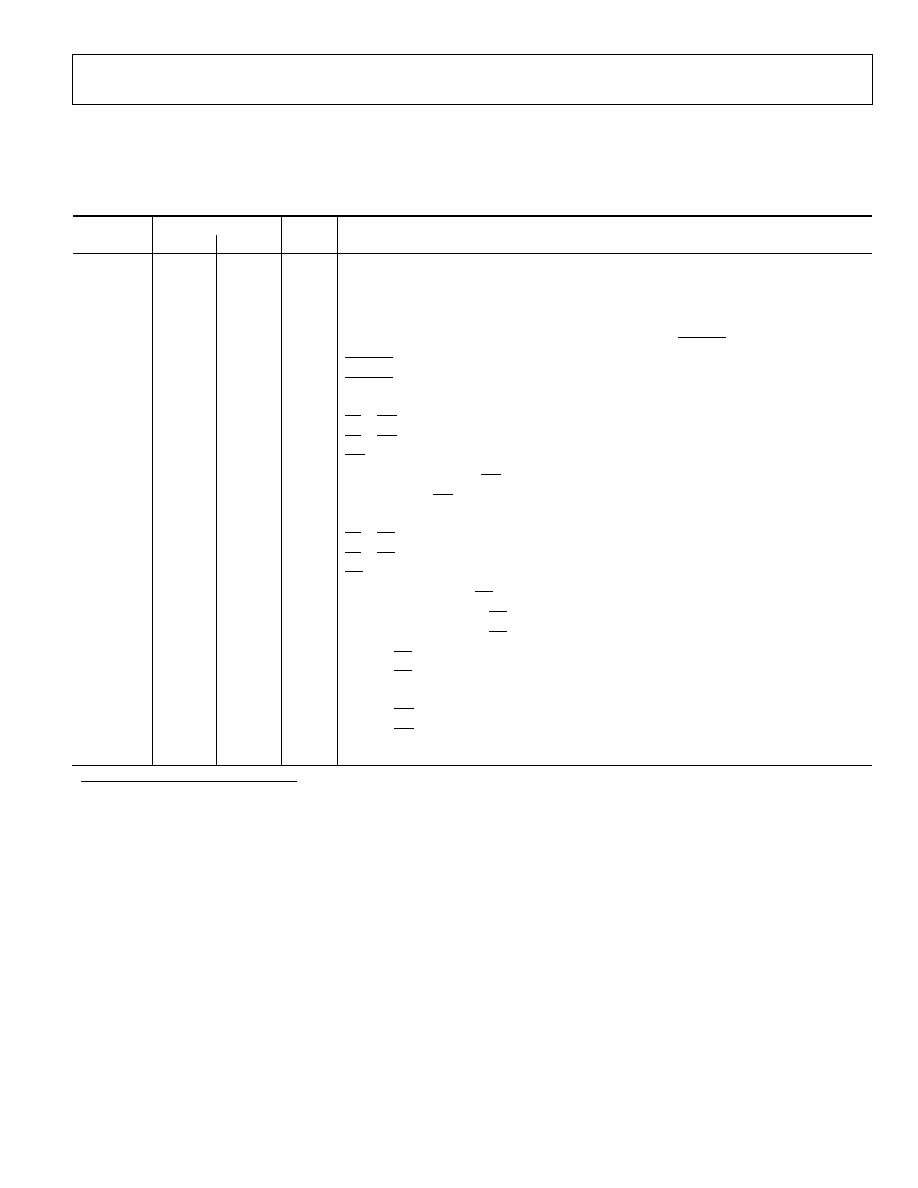
Preliminary Technical Data
AD7933/AD7934
TIMING SPECIFICATIONS
1
V
DD
= V
DRIVE
=2.7 V to 5.25 V, Internal/External V
REF
= 2.5 V, unless otherwise noted, F
CLKIN
= 24 MHz, F
SAMPLE
= 1.5 MSPS; T
A
= T
MIN
to
T
MAX
, unless otherwise noted.
Table 3.
Limit at T
MIN
, T
MAX
Parameter AD7933
AD7934
Unit
Description
f
CLKIN
2
10 10
kHz
min
24
24
MHz
max
t
QUIET
10
10
ns min
Minimum time between end of read and start of next conversion, i.e., time from when the
data bus goes into three-state until the next falling edge of CONVST.
t
1
10
10
ns min
CONVST Pulse Width.
t
2
20
20
ns min
CONVST Falling Edge to CLKIN Falling Edge Setup Time.
t
3
TBD
TBD
ns min
CLKIN Falling Edge to BUSY Rising Edge.
t
4
0
0
ns min
CS to WR Setup Time.
t
5
0
0
ns
min
CS to WR Hold Time.
t
6
25
25
ns
min
WR Pulse Width.
t
7
10
10
ns min
Data Setup Time before WR.
t
8
5
5
ns min
Data Hold after WR.
t
9
0.5
t
CLKIN
0.5 t
CLKIN
ns min
New Data Valid before Falling Edge of BUSY.
t
10
0
0
ns min
CS to RD Setup Time.
t
11
0
0
ns min
CS to RD Hold Time.
t
12
55
55
ns min
RD Pulse Width.
t
13
3
50
50
ns max
Data Access Time after RD.
t
14
4
5
5
ns min
Bus Relinquish Time after RD.
40
40
ns max
Bus Relinquish Time after RD.
t
15
15
15
ns min
HBEN to RD Setup Time.
t
16
5
5
ns min
HBEN to RD Hold Time.
t
17
10
10
ns min
Minimum Time between Reads/Writes.
t
18
0
0
ns min
HBEN to WR Setup Time.
t
19
5
5
ns min
HBEN to WR Hold Time.
t
20
TBD
TBD
ns min
CLKIN Falling Edge to BUSY Rising Edge.
1
Sample tested during initial release to ensure compliance. All input signals are specified with tr = tf = 5 ns (10% to 90% of V
DD
) and timed from a voltage level of 1.6 V.
All timing specifications given above are with a 25 pF load capacitance. See
,
,
, and
.
Figure 37. AD7933/AD7934 Parallel Interface--Conversion and Read Cycle in Word Mode
(W/ = 1) Figure 38 Figure 39
Figure 40
2
Mark/space ratio for CLKIN is 40/60 to 60/40.
3
The time required for the output to cross TBD.
4
t
14
is derived from the measured time taken by the data outputs to change 0.5 V. The measured number is then extrapolated back to remove the effects of charging or
discharging the 25 pF capacitor. This means that the time, t
14
, quoted in the timing characteristics is the true bus relinquish time of the part and is independent of the
bus loading.
Rev. PrG | Page 7 of 32
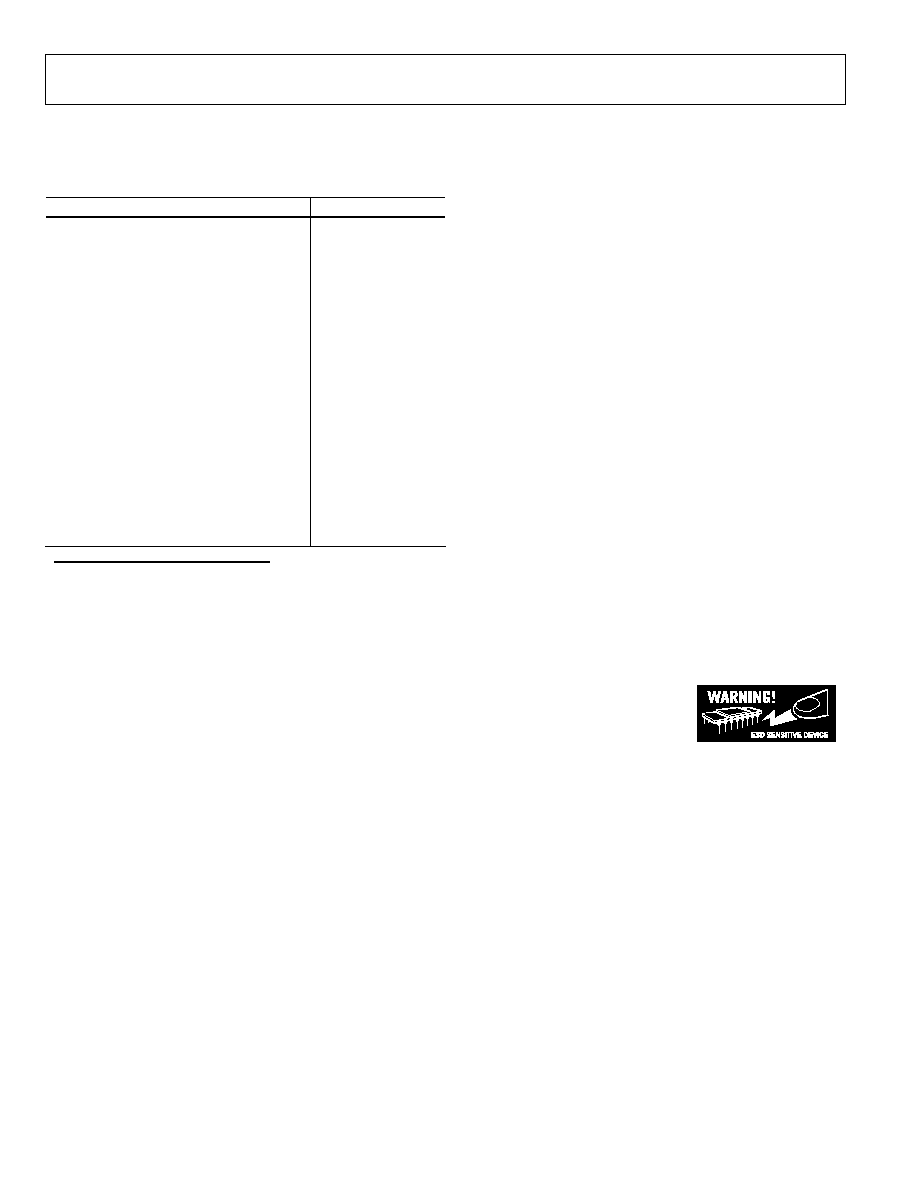
AD7933/AD7934
Preliminary Technical Data
ABSOLUTE MAXIMUM RATINGS
T
A
= 25°C, unless otherwise noted.
Table 4.
Parameter Rating
V
DD
to AGND/DGND
-0.3 V to +7 V
V
DRIVE
to AGND/DGND
-0.3 V to V
DD
+0.3 V
Analog Input Voltage to AGND
-0.3 V to V
DD
+ 0.3 V
Digital Input Voltage to DGND
-0.3 V to +7 V
V
DRIVE
to V
DD
-0.3 V to V
DD
+ 0.3 V
Digital Output Voltage to AGND
-0.3 V to V
DRIVE
+ 0.3 V
V
REFIN
to AGND
-0.3 V to V
DD
+ 0.3 V
AGND to DGND
-0.3 V to +0.3 V
Input Current to Any Pin Except Supplies
1
±10
mA
Operating Temperature Range
Commercial (B Version)
-40°C to +85°C
Storage Temperature Range
-65°C to +150°C
Junction Temperature
150°C
JA
Thermal Impedance
97.9°C/W (TSSOP)
JC
Thermal Impedance
14°C/W (TSSOP)
Lead Temperature, Soldering
Reflow Temperature (10 sec to 30 sec)
255°C
ESD 2
kV
1
Transient currents of up to 100 mA will not cause SCR latch-up.
Stresses above those listed under Absolute Maximum Ratings
may cause permanent damage to the device. This is a stress
rating only; functional operation of the device at these or any
other conditions above those listed in the operational sections
of this specification is not implied. Exposure to absolute
maximum rating conditions for extended periods may affect
device reliability.
ESD CAUTION
ESD (electrostatic discharge) sensitive device. Electrostatic charges as high as 4000 V readily accumulate
on the human body and test equipment and can discharge without detection. Although this product features
proprietary ESD protection circuitry, permanent damage may occur on devices subjected to high energy
electrostatic discharges. Therefore, proper ESD precautions are recommended to avoid performance
degradation or loss of functionality.
Rev. PrG | Page 8 of 32
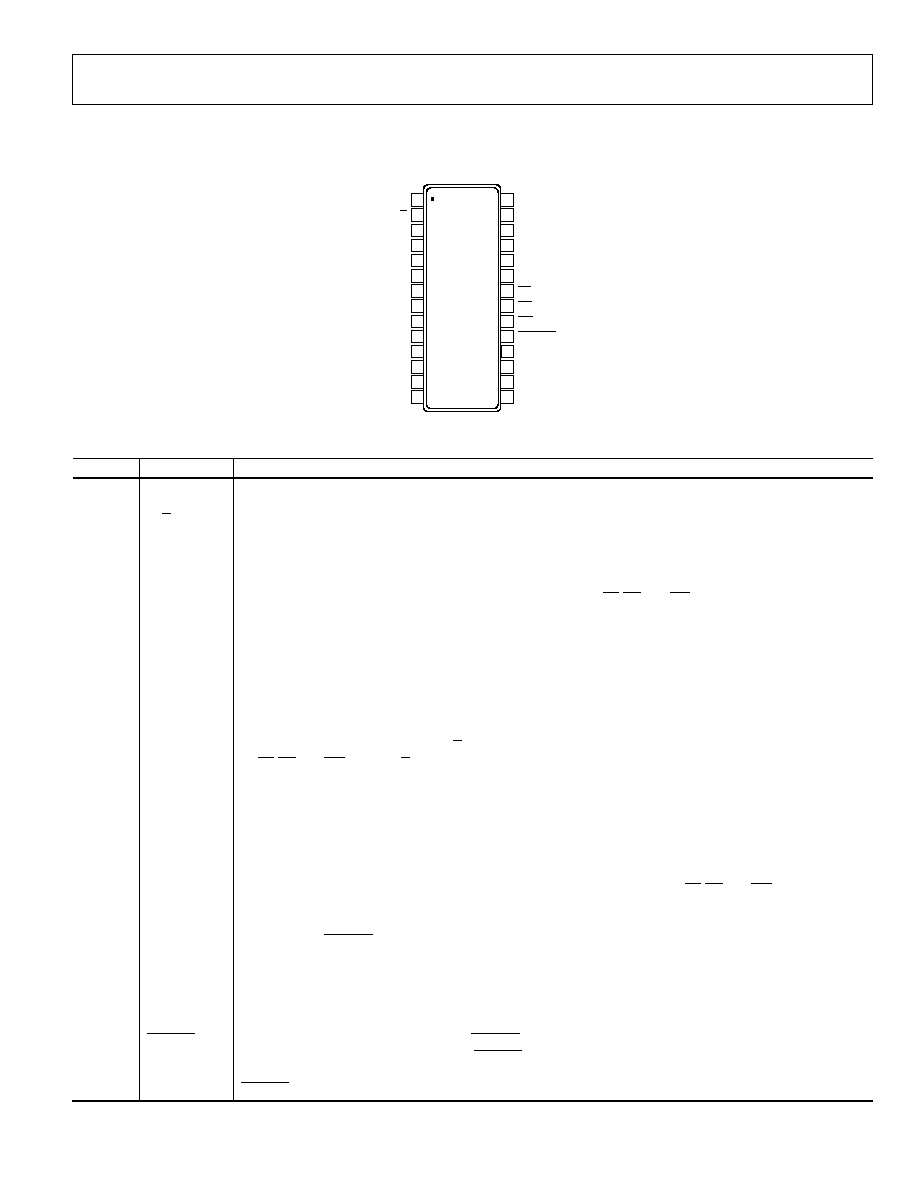
Preliminary Technical Data
AD7933/AD7934
PIN CONFIGURATION AND FUNCTION DESCRIPTIONS
1
2
3
4
5
6
7
8
9
10
11
12
13
14
28
27
26
25
24
23
22
21
20
19
18
17
16
15
W/B
DB0
DB1
DB4
DB3
DB2
V
DD
V
IN
2
V
IN
1
V
IN
0
CS
AGND
V
REFIN/
V
REFOUT
DB5
DB6
DB7
DB9
DGND
V
DRIVE
RD
WR
CONVST
DB10
DB8/HBEN
DB11
BUSY
CLKIN
V
IN
3
AD7933/
AD7934
TOP VIEW
(Not to Scale)
03713-0-006
Figure 2. Pin Configuration
Table 5. Pin Function Description
Pin No.
Mnemonic
Description
1
V
DD
Power Supply Input. The V
DD
range for the AD7933/AD7934 is from 2.7 V to 5.25 V. The supply should be
decoupled to AGND with a 0.1 µF capacitor and a 10 µF tantalum capacitor.
2
W/B
Word/Byte Input. When this input is logic high, word transfer mode is enabled and data is transferred to and
from the AD7933/AD7934 in 12-/10-bit words on Pins DB0/DB2 to DB11. When this pin is logic low, byte
transfer mode is enabled. Data and the channel ID is transferred on Pins DB0 to DB7 and Pin DB8/HBEN
assumes its HBEN functionality.
3 to 10
DB0 to DB7
Data Bits 0 to 7. Three-state parallel digital I/O pins that provide the conversion result and also allow the
control register to be programmed. These pins are controlled by CS, RD, and WR. The logic high/low voltage
levels for these pins are determined by the V
DRIVE
input. When reading from the AD7933, the two LSBs (DB0 and
DB1) are always 0 and the LSB of the conversion result is available on DB2.
11
V
DRIVE
Logic Power Supply Input. The voltage supplied at this pin determines at what voltage the parallel interface of
the AD7933/AD7934 will operate. This pin should be decoupled to DGND. The voltage at this pin may be
different to that at V
DD
but should never exceed V
DD
by more than 0.3 V.
12
DGND
Digital Ground. This is the ground reference point for all digital circuitry on the AD7933/AD7934. The DGND
and AGND voltages should ideally be at the same potential and must not be more than 0.3 V apart, even on a
transient basis.
13
DB8/HBEN
Data Bit 8/High Byte Enable. When W/B is high, this pin acts as Data Bit 8, a three-state I/O pin that is controlled
by CS, RD, and WR. When W/B is low, this pin acts as the high byte enable pin. When HBEN is low, the low byte
of data written to or read from the AD7933/AD7934 is on DB0 to DB7. When HBEN is high, the top four bits of
the data being written to or read from the AD7933/AD7934 are on DB0 to DB3 When reading from the device,
DB4 of the high byte is always 0 and DB5 and DB6 will contain the ID of the channel for which the conversion
result corresponds (see Channel Address Bits in Table 9). When writing to the device, DB4 to DB7 of the high
byte must be all 0s. Note that when reading from the AD7933, the two LSBs in the low byte are 0s and the
remaining 6 bits, conversion data.
14 to 16
DB9 to DB11
Data Bits 9 to 11. Three-state parallel digital I/O pins that provide the conversion result and also allow the
control register to be programmed in word mode. These pins are controlled by CS, RD, and WR. The logic
high/low voltage levels for these pins are determined by the V
DRIVE
input.
17
BUSY
Busy Output. Logic output indicating the status of the conversion. The BUSY output goes high following the
falling edge of CONVST and stays high for the duration of the conversion. Once the conversion is complete and
the result is available in the output register, the BUSY output will go low. The track-and-hold returns to track
mode just prior to the falling edge of BUSY, and the acquisition time for the part begins when BUSY goes low.
18
CLKIN
Master Clock Input. The clock source for the conversion process is applied to this pin. Conversion time for the
AD7933/AD7934 takes 13.5 clock cycles. The frequency of the master clock input therefore determines the
conversion time and achievable throughput rate.
19
CONVST
Conversion Start Input. A falling edge on CONVST is used to initiate a conversion. The track-and-hold goes from
track to hold mode on the falling edge of CONVST and the conversion process is initiated at this point.
Following power-down, when operating in the auto shutdown or auto standby mode, a rising edge on
CONVST is used to power up the device.
Rev. PrG | Page 9 of 32
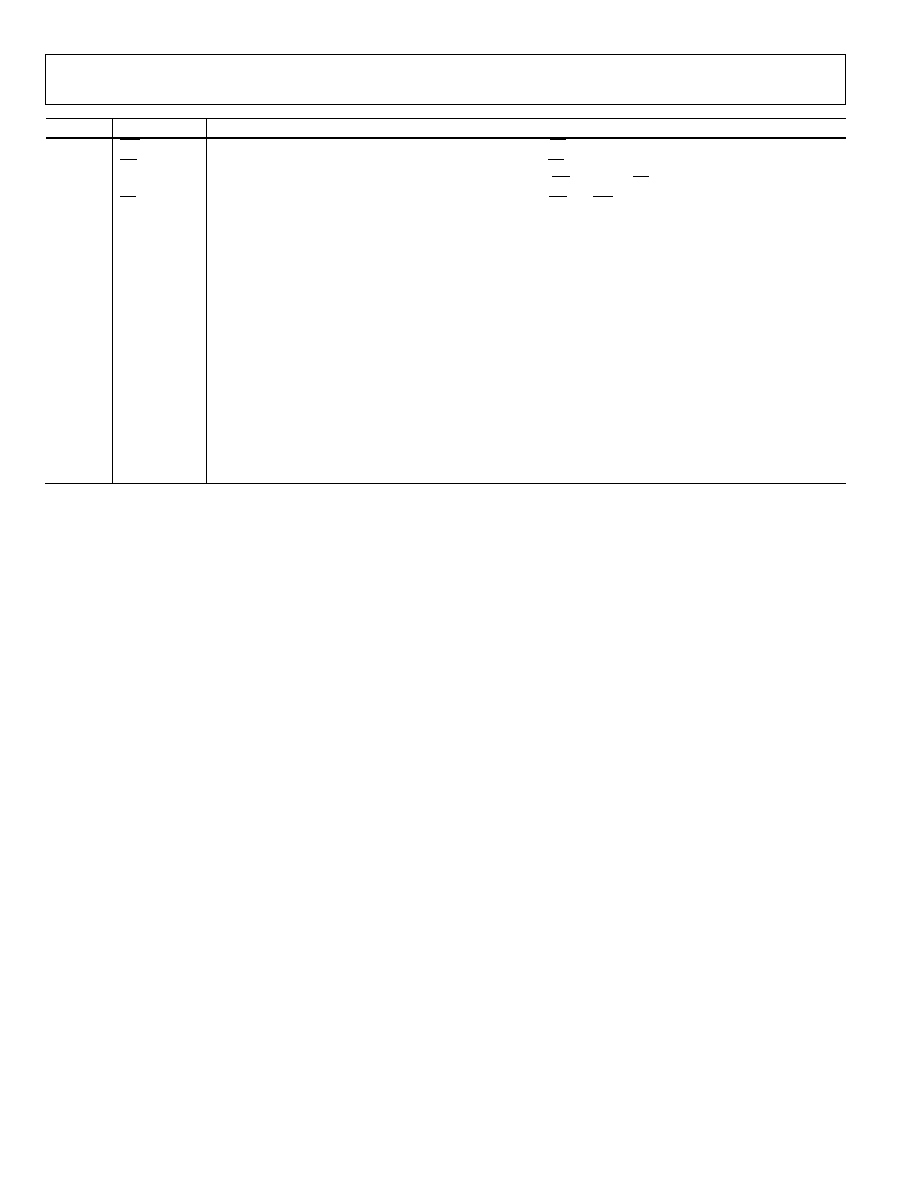
AD7933/AD7934
Preliminary Technical Data
Pin No.
Mnemonic
Description
20
WR
Write Input. Active low logic input used in conjunction with CS to write data to the control register.
21
RD
Read Input. Active low logic input used in conjunction with CS to access the conversion result. The conversion
result is placed on the data bus following the falling edge of RD read while CS is low.
22
CS
Chip Select. Active low logic input used in conjunction with RD and WR to read conversion data or write data to
the control register.
23
AGND
Analog Ground. This is the ground reference point for all analog circuitry on the AD7933/AD7934. All analog
input signals and any external reference signal should be referred to this AGND voltage. The AGND and DGND
voltages should ideally be at the same potential and must not be more than 0.3 V apart, even on a transient
basis.
24 V
REFIN
/V
REFOUT
Reference Input/Output. This pin is connected to the internal reference and is the reference source for the ADC.
The nominal internal reference voltage is 2.5 V and this appears at this pin. This pin can be overdriven by an
external reference. The input voltage range for the external reference is 0.1 V to 3.5 V for differential mode and
is 0.1 V to V
DD
in single-ended and pseudo-differential mode, depending on V
DD
.
25 to 28
V
IN
0 to V
IN
3
Analog Input 0 to Analog Input 3. Four analog input channels that are multiplexed into the on-chip track-and-
hold. The analog inputs can be programmed to be four single ended inputs, two fully differential pairs or two
pseudo-differential pairs by setting the MODE bits in the control register appropriately (see Table 9). The
analog input channel to be converted can either be selected by writing to the address bits (ADD1 and ADD0) in
the control register prior to the conversion, or the on-chip sequencer can be used. The input range for all input
channels can either be 0 V to V
REF
or 0 V to 2 × V
REF
and the coding can be binary or twos complement,
depending on the states of the RANGE and CODING bits in the control register. Any unsed input channels
should be connected to AGND to avoid noise pickup.
Rev. PrG | Page 10 of 32

AD7933/AD7934
Preliminary Technical Data
TERMINOLOGY
Integral Nonlinearity
This is the maximum deviation from a straight line passing
through the endpoints of the ADC transfer function. The
endpoints of the transfer function are zero scale, a point 1 LSB
below the first code transition, and full scale, a point 1 LSB
above the last code transition.
Negative Gain Error Match
This is the difference in negative gain error between any two
channels.
Channel-to-Channel Isolation
It is a measure of the level of crosstalk between channels. It is
measured by applying a full-scale sine wave signal to the three
nonselected input channels and applying a 50 kHz signal to the
selected channel. The channel-to-channel isolation is defined as
the ratio of the power of the 50 kHz signal on the selected
channel to the power of the noise signal that appears in the FFT
of this channel.
Differential Nonlinearity
This is the difference between the measured and the ideal 1 LSB
change between any two adjacent codes in the ADC.
Offset Error
This is the deviation of the first code transition (00 . . .000) to
(00 . . . 001) from the ideal, i.e., AGND + 1 LSB
Power Supply Rejection Ratio (PSRR)
It is defined as the ratio of the power in the ADC output at full-
scale frequency, f, to the power of a 100 mV p-p sine wave
applied to the ADC V
DD
supply of frequency f
S
. The frequency
of the input varies from 1 kHz to 1 MHz.
Offset Error Match
This is the difference in offset error between any two channels.
Gain Error
This is the deviation of the last code transition (111 . . .110) to
(111 . . . 111) from the ideal (i.e., V
REF
1 LSB) after the offset
error has been adjusted out.
PSRR (dB) = 10log(Pf/Pf
S
)
Pf is the power at frequency f in the ADC output; Pf
S
is the
power at frequency f
S
in the ADC output.
Gain Error Match
This is the difference in gain error between any two channels.
Track-and-Hold Acquisition Time
The track-and-hold amplifier returns into track mode and the
end of conversion. The track-and-hold acquisition time is the
time required for the output of the track-and-hold amplifier to
reach its final value, within ±1/2 LSB, after the end of
conversion.
Zero-Code Error
This applies when using the twos complement output coding
option, in particular to the 2 × V
REF
input range with -V
REF
to
+V
REF
biased about the V
REFIN
point. It is the deviation of the
midscale transition (all 0s to all 1s) from the ideal V
IN
voltage,
i.e., V
REF
.
Signal-to-(Noise + Distortion) Ratio (SINAD)
This is the measured ratio of signal-to-(noise + distortion) at
the output of the ADC. The signal is the rms amplitude of the
fundamental. Noise is the sum of all nonfundamental signals up
to half the sampling frequency (f
S
/2), excluding dc. The ratio is
dependent on the number of quantization levels in the
digitization process; the more levels, the smaller the
quantization noise. The theoretical signal-to-(noise +
distortion) ratio for an ideal N-bit converter with a sine wave
input is given by
Zero-Code Error Match
This is the difference in zero-code error between any two
channels.
Positive Gain Error
This applies when using the twos complement output coding
option, in particular to the 2 × V
REF
input range with -V
REF
to
+V
REF
biased about the V
REFIN
point. It is the deviation of the last
code transition (011. . .110) to (011 .. . 111) from the ideal (i.e.,
+V
REF
1 LSB) after the zero-code error has been adjusted out.
Signal-to-(Noise + Distortion) = (6.02 N + 1.76) dB
Positive Gain Error Match
This is the difference in positive gain error between any two
channels.
Thus, for a 12-bit converter, this is 74 dB, and for a 10-bit
converter, this is 62 dB.
Negative Gain Error
This applies when using the twos complement output coding
option, in particular to the 2 × V
REF
input range with -V
REF
to
+V
REF
biased about the V
REF
point. It is the deviation of the first
code transition (100 . . . 000) to (100 . . . 001) from the ideal (i.e.,
-V
REFIN
+ 1 LSB) after the zero-code error has been adjusted
out.
Rev. PrG | Page 11 of 32

AD7933/AD7934
Preliminary Technical Data
Total Harmonic Distortion (THD)
THD is the ratio of the rms sum of harmonics to the
fundamental. For the AD7933/AD7934, it is defined as
( )
1
6
5
4
3
2
V
V
V
V
V
V
THD
2
2
2
2
2
20log
dB
+
+
+
+
-
=
where V
1
is the rms amplitude of the fundamental and V
2
, V
3
,
V
4
, V
5
, and V
6
are the rms amplitudes of the second through the
sixth harmonics.
Peak Harmonic or Spurious Noise
Peak harmonic or spurious noise is defined as the ratio of the
rms value of the next largest component in the ADC output
spectrum (up to f
S
/2 and excluding dc) to the rms value of the
fundamental. Normally, the value of this specification is
determined by the largest harmonic in the spectrum, but for
ADCs where the harmonics are buried in the noise floor, it will
be a noise peak
Intermodulation Distortion
With inputs consisting of sine waves at two frequencies, fa and
fb, any active device with nonlinearities will create distortion
products at sum and difference frequencies of mfa ± nfb where
m, n = 0, 1, 2, 3, etc. Intermodulation distortion terms are those
for which neither m nor n are equal to zero. For example, the
second-order terms include (fa + fb) and (fa - fb), while the
third-order terms include (2fa + fb), (2fa - fb), (fa + 2fb) and (fa
- 2fb).
The AD7933/AD7934 is tested using the CCIF standard where
two input frequencies near the top end of the input bandwidth
are used. In this case, the second-order terms are usually
distanced in frequency from the original sine waves, while the
third-order terms are usually at a frequency close to the input
frequencies. As a result, the second- and third-order terms are
specified separately. The calculation of the intermodulation
distortion is as per the THD specification where it is the ratio of
the rms sum of the individual distortion products to the rms
amplitude of the sum of the fundamentals expressed in dBs.
Rev. PrG | Page 12 of 32
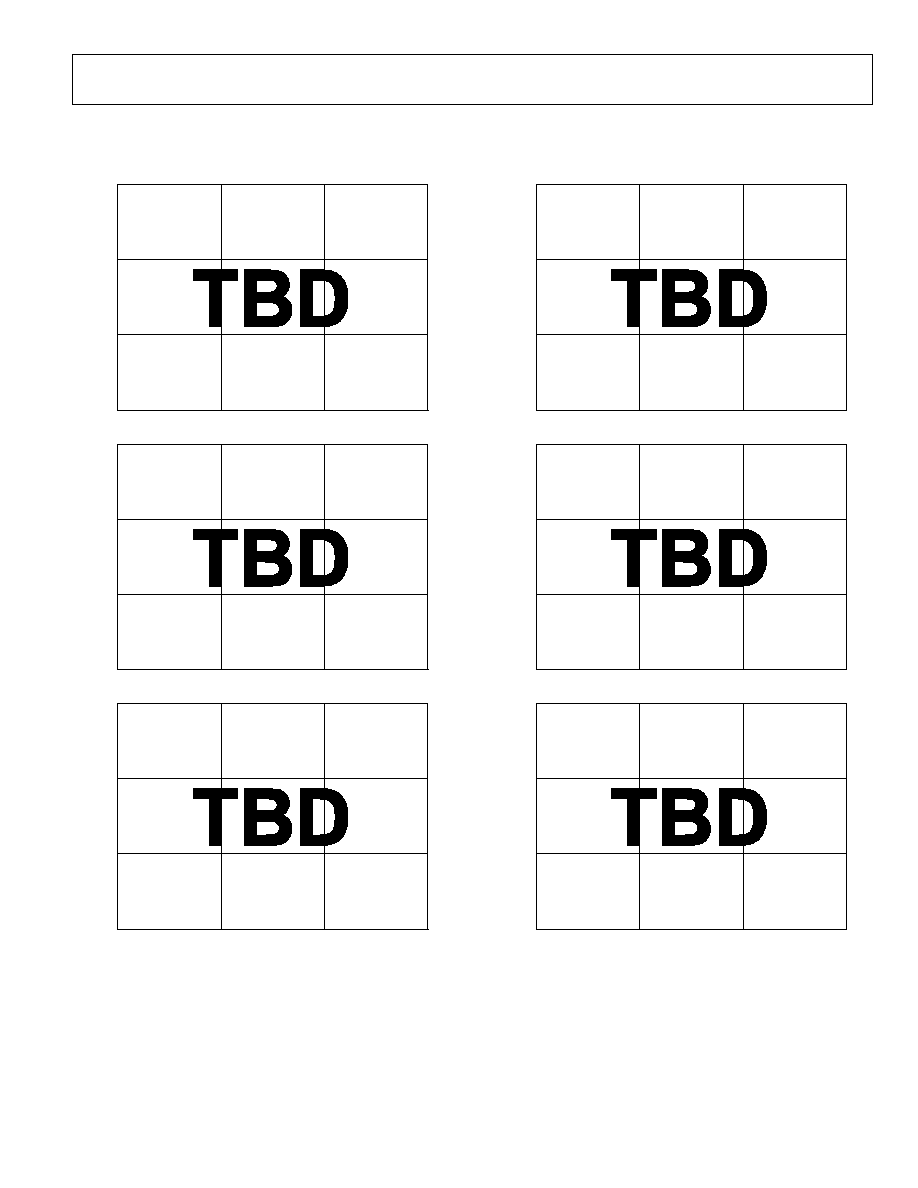
Preliminary Technical Data
AD7933/AD7934
TYPICAL PERFORMANCE CHARACTERISTICS
T
A
= 25°C, unless otherwise noted.
Figure 3. PSRR vs. Supply Ripple Frequency Without Supply Decoupling
Figure 4. Channel-to-Channel Isolation
Figure 5. AD7934 SINAD vs. Analog Input Frequency for Various Supply Voltages
Figure 6. AD7934 FFT @ V
DD
= 5 V
Figure 7. AD7934 Typical DNL @ V
DD
= 5 V
Figure 8. AD7934 Typical INL @ V
DD
= 5 V
Rev. PrG | Page 13 of 32
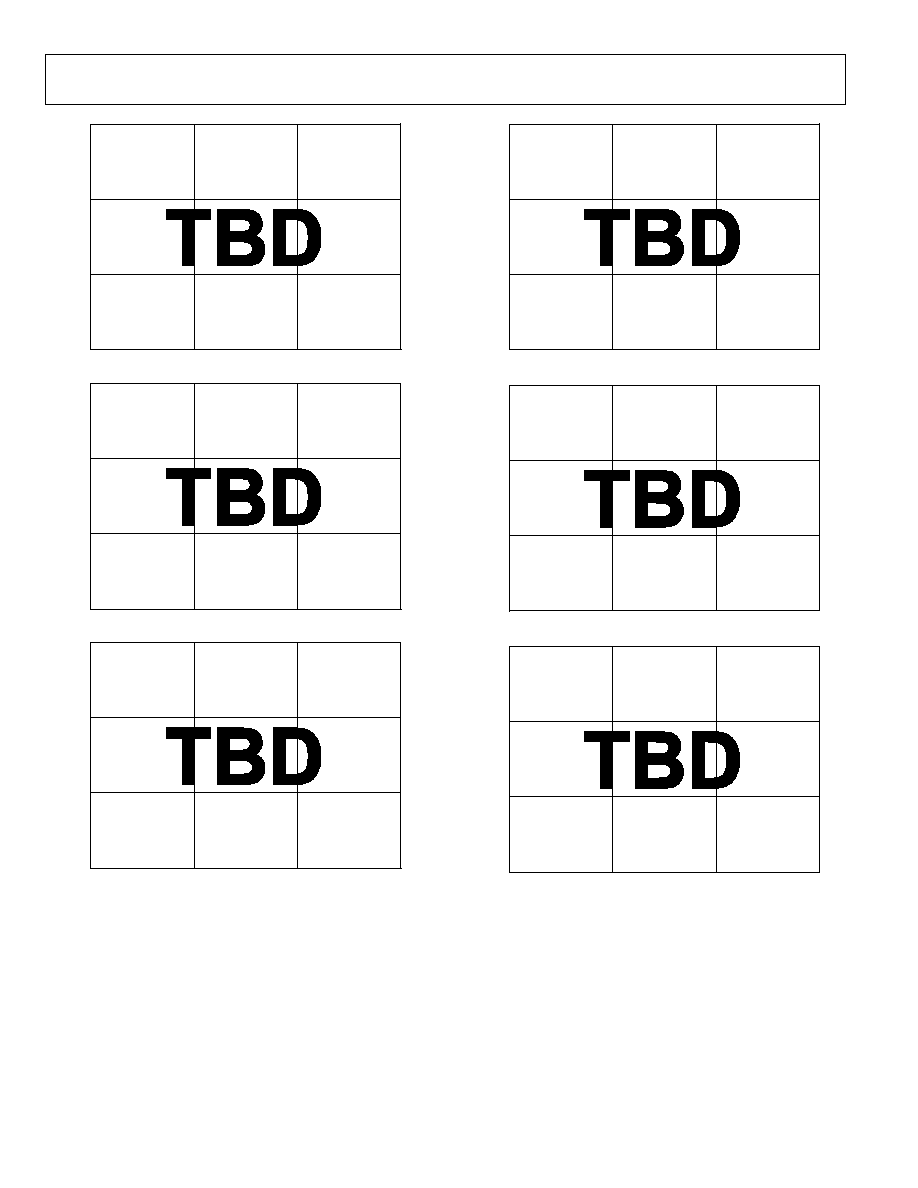
AD7933/AD7934
Preliminary Technical Data
Figure 9. AD7934 Change in INL vs. V
REF
for V
DD
= 5 V
Figure 10.AD7934 Change in DNL vs. V
REF
for V
DD
= 5 V
Figure 11. AD7934 Change in ENOB vs. V
REF
for V
DD
= 5 V
Figure 12. AD7934 Offset vs. V
REF
Figure 13. AD7934 Histogram of Codes @ V
DD
= 5 V with the Internal Reference
Figure 14. AD7934 Histogram of Codes @ V
DD
= 5 V with an External Reference
Rev. PrG | Page 14 of 32
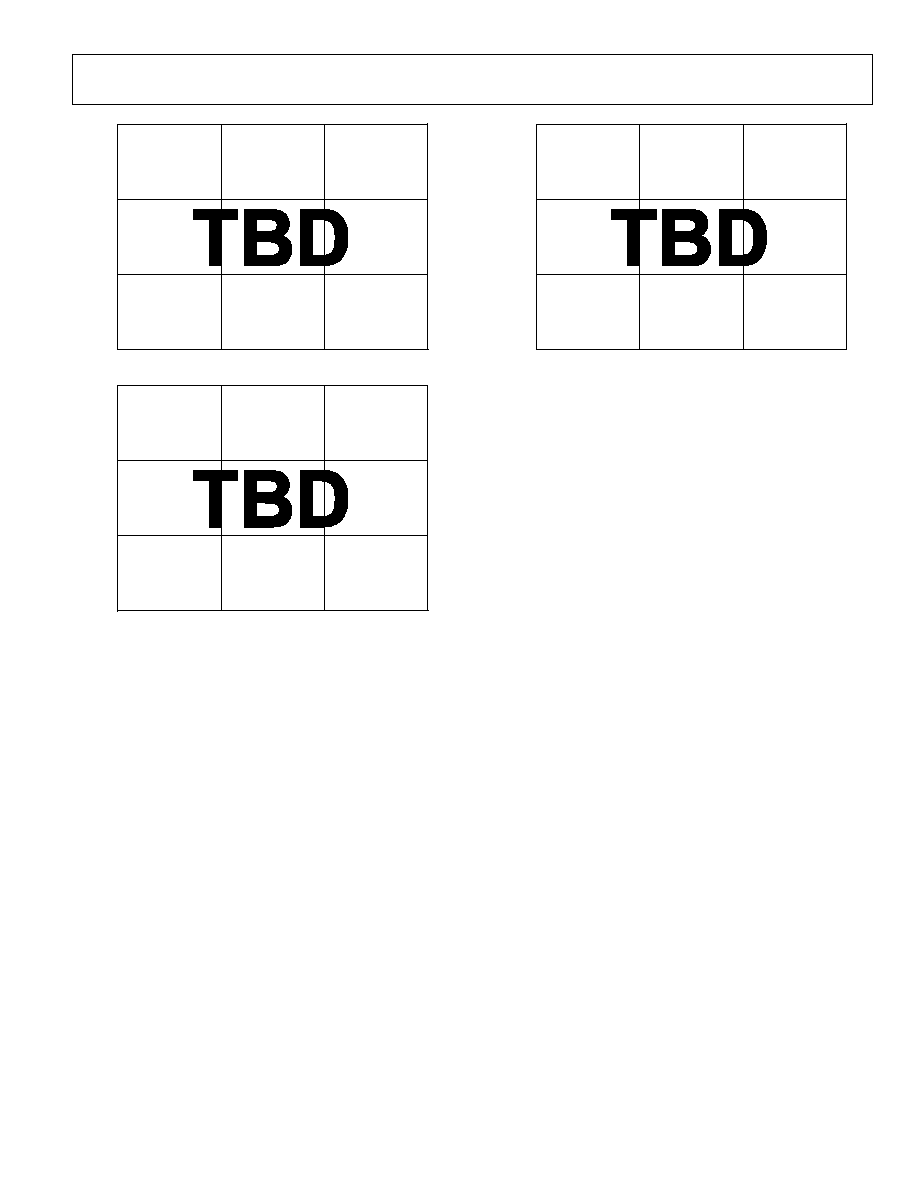
Preliminary Technical Data
AD7933/AD7934
Figure 15. AD7933 FFT @ V
DD
= 5 V
Figure 16. AD7933 Typical DNL @ V
DD
= 5 V
Figure 17. AD7933 Typical INL @ V
DD
= 5 V
Rev. PrG | Page 15 of 32
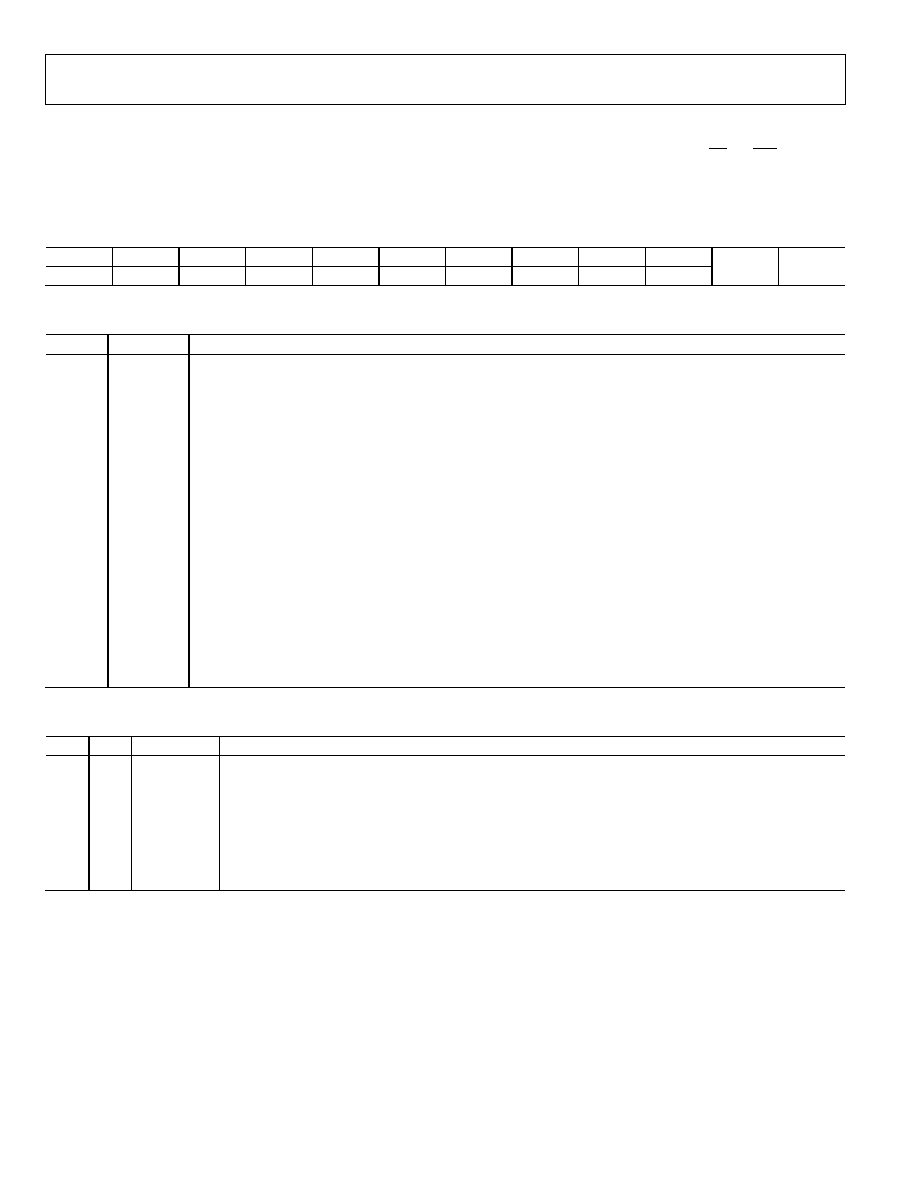
AD7933/AD7934
Preliminary Technical Data
CONTROL REGISTER
The control register on the AD7933/AD7934 is a 12-bit, write-only register. Data is written to this register using the CS and WR pins. The
control register is shown below and the functions of the bits are described in
. At power-up, the default bit settings in the control
register are all 0s.
Table 7
Table 7. Control Register Bit Function Description
Table 6. Control Register Bits
MSB
LSB
D11
D10
D9 D8 D7 D6 D5 D4 D3 D2 D1 D0
PM1 PM0 CODING
REF ZERO ADD1
ADD0
MODE1
MODE0
SEQ1 SEQ0 RANGE
Bit No.
Mnemonic Description
11, 10
PM1, PM0
Power Management Bits. These two bits are used to select the power mode of operation. The user can choose
between either normal mode or various power-down modes of operation as shown in
.
9
CODING
This bit selects the output coding of the conversion result. If this bit is set to 0, the output coding is straight
(natural) binary. If this bit is set to 1, the output coding is twos complement.
8
REF
This bit selects whether the internal or an external reference is used to perform the conversion. If this bit is Logic 0,
an external reference should be applied to the V
REF
pin, and if it is Logic 1, the internal reference is selected (see
the Reference Section).
7
ZERO
This bit is not used so it should always be set to Logic 0.
6, 5
ADD1,
ADD0
These two address bits are used to either select which analog input channel is to be converted in the next
conversion, if the sequencer is not being used, or to select the final channel in a consecutive sequence when the
sequencer is being used as described in
. The selected input channel is decoded as shown in
.
4, 3
MODE1,
MODE0
The two mode pins select the type of analog input on the four V
IN
pins. The AD7933/AD7934 have either four
single-ended inputs, two fully differential inputs, or two pseudo-differential inputs (see
).
2
SEQ1
The SEQ1 bit in the control register is used in conjunction with the SEQ0 bit to control the sequencer function (see
).
1
SEQ0
The SEQ0 bit in the control register is used in conjunction with the SEQ1 bit to control the sequencer function (see
).
0
RANGE
This bit selects the analog input range of the AD7933/AD7934. If it is set to 0, the analog input range extends from
0 V to V
REF
. If it is set to 1, the analog input range extends from 0 V to 2 × V
REF
. When this range is selected, AV
DD
must be 4.75 V to 5.25 V.
Table 8
Table 8. Power Mode Selection using the Power Management Bits in the Control Register
Table 10
Table 10
Table 10
Table 9
Table 9
PM1 PM0 Mode
Description
0 0 Normal
Mode
When operating in normal mode, all circuitry is fully powered up at all times.
0 1 Auto
Shutdown
When operating in auto shutdown mode, the AD7933/AD7934 will enter full shutdown mode at the end of
each conversion. In this mode, all circuitry is powered down.
1 0 Auto
Standby
When the AD7933/AD7934 enter this mode, all circuitry is partially powered down. This mode is similar to
the auto shutdown mode but it allows the part to power up in 1 µs.
1 1 Full
Shutdown
When the AD7933/AD7934 enters this mode, all circuitry is powered down. The information in the control
register is retained.
Rev. PrG | Page 16 of 32
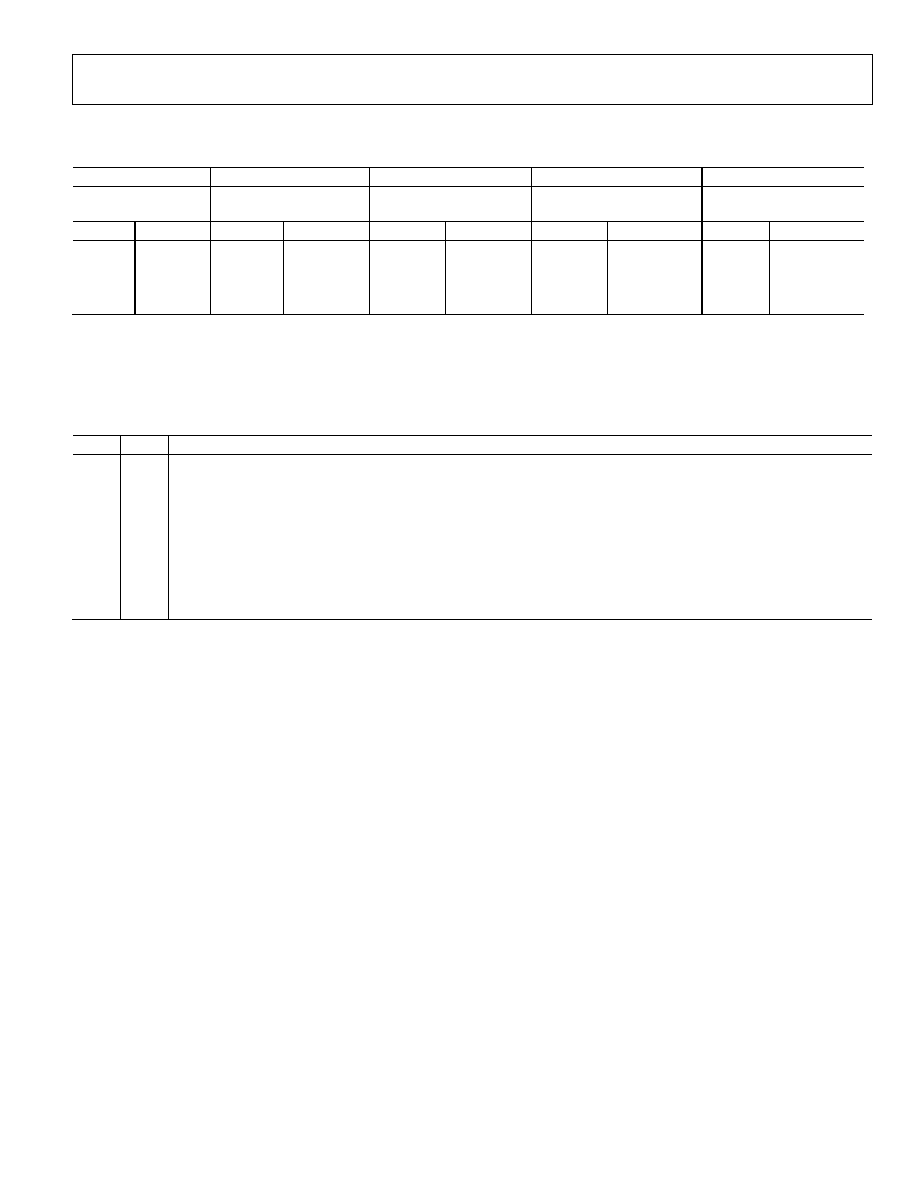
Preliminary Technical Data
AD7933/AD7934
Table 9. Analog Input Type Selection
Channel Address
MODE0 = 0, MODE1 = 0
MODE0 = 0, MODE1 = 1
MODE0 = 1, MODE1 = 0
MODE0 = 1, MODE1 = 1
Four Single-Ended I/P
Channels
Two Fully Differential
I/P Channels
Two Pseudo-Differential
I/P Channels
Not Used
ADD1
ADD0
V
IN+
V
IN-
V
IN+
V
IN-
V
IN+
V
IN-
0
0
VIN0
AGND
VIN0
VIN1
VIN0
VIN1
0
1
VIN1
AGND
VIN1
VIN0
VIN1
VIN0
1
0
VIN2
AGND
VIN2
VIN3
VIN2
VIN3
1
1
VIN3
AGND
VIN3
VIN2
VIN3
VIN2
SEQUENCER OPERATION
The configuration of the SEQ0 and SEQ1 bits in the control register allow the user to use the sequencer function. T
outlines the
two sequencer modes of operation.
able 10
Table 10. Sequence Selection Modes
SEQ0 SEQ1 Sequence
Type
0 0
This configuration is selected when the sequence function is not used. The analog input channel selected on each
individual conversion is determined by the contents of the channel address bits, ADD1 and ADD0, in each prior write
operation. This mode of operation reflects the normal operation of a multichannel ADC, without the sequencer function
being used, where each write to the AD7933/AD7934 selects the next channel for conversion.
0 1 Not
Used.
1
0
Not Used.
1 1 This configuration is used in conjunction with the channel address bits, ADD1 and ADD0, to program continuous
conversions on a consecutive sequence of channels from Channel 0 through to a selected final channel as determined by
the channel address bits in the control register. When in differential or pseudo-differential mode, inverse channels (e.g.,
VIN1, VIN0) are not converted in this mode.
Rev. PrG | Page 17 of 32
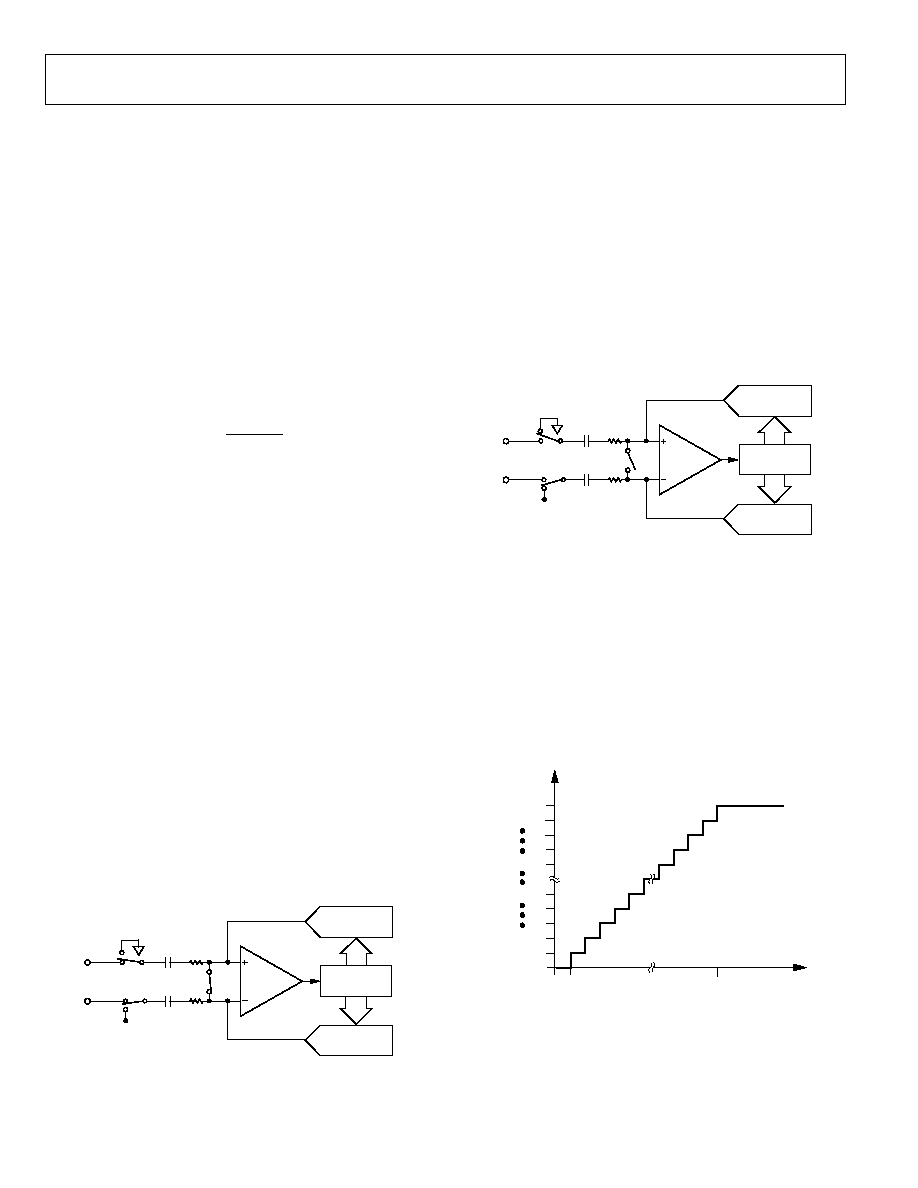
AD7933/AD7934
Preliminary Technical Data
CIRCUIT INFORMATION
The AD7933/AD7934 are fast, 4-channel, 12-bit and10-bit,
single-supply, successive approximation analog-to-digital
converters. The parts operate from either a 2.7 V to 3.6 V or
4.75 V to 5.25 V power supply and feature throughput rates up
to 1.5 MSPS.
When the ADC starts a conversion (Figure 19), SW3 will open
and SW1 and SW2 will move to Position B, causing the
comparator to become unbalanced. Both inputs are
disconnected once the conversion begins. The control logic and
charge redistribution DACs are used to add and subtract fixed
amounts of charge from the sampling capacitor arrays to bring
the comparator back into a balanced condition. When the
comparator is rebalanced, the conversion is complete. The
control logic generates the ADC's output code. The output
impedances of the sources driving the V
IN+
and the V
IN-
pins
must be matched; otherwise, the two inputs will have different
settling times, resulting in errors.
The AD7933/AD7934 provide the user with an on-chip track-
and-hold, an internal accurate reference, an analog-to-digital
converter, and a parallel interface housed in a 28-lead TSSOP
package.
The AD7933/AD7934 have four analog input channels that can
be configured to be four single-ended inputs, two fully
differential pairs, or two pseudo-differential pairs. There is an
on-chip channel sequencer that allows the user to select a
consecutive sequence of channels through which the ADC can
cycle with each falling edge of CONVST.
03713-0-024
V
IN+
V
IN
A
B
SW1
SW3
COMPARATOR
CONTROL
LOGIC
CAPACITIVE
DAC
CAPACITIVE
DAC
C
S
C
S
V
REF
SW2
B
A
The analog input range for the AD7933/AD7934 is 0 to V
REF
or
0 to 2 × V
REF
, depending on the status of the RANGE bit in the
control register. The output coding of the ADC can be either
binary or twos complement, depending on the status of the
CODING bit in the control register.
Figure 19. ADC Conversion Phase
ADC TRANSFER FUNCTION
The AD7933/AD7934 provide flexible power management
options to allow users to achieve the best power performance
for a given throughput rate. These options are selected by
programming the power management bits, PM1 and PM0, in
the control register.
The output coding for the AD7933/AD7934 is either straight
binary or twos complement, depending on the status of the
CODING bit in the control register. The designed code
transitions occur at successive LSB values (i.e., 1 LSB, 2 LSBs,
and so on) and the LSB size is V
REF
/1024 for the AD7933 and
V
REF
/4096 for the AD7934. The ideal transfer characteristics of
the AD7933/AD7934 for both straight binary and twos
complement output coding are shown in Figure 20 and Figure 21,
respectively.
CONVERTER OPERATION
The AD7933/AD7934 are a successive approximation ADC
based on two capacitive DACs. Figure 18 and Figure 19 show
simplified schematics of the ADC in acquisition and conversion
phase, respectively. The ADC comprises of control logic, a SAR,
and two capacitive DACs. Both figures show the operation of
the ADC in differential/pseudo-differential mode. Single-ended
mode operation is similar but V
IN-
is internally tied to AGND.
In the acquisition phase, SW3 is closed, SW1 and SW2 are in
Position A, the comparator is held in a balanced condition, and
the sampling capacitor arrays acquire the differential signal on
the input.
03713-0-025
000...000
111...111
1 LSB = V
REF
/4096 (AD7934)
1 LSB = V
REF
/1024 (AD7933)
1 LSB
+V
REF
1 LSB
ANALOG INPUT
ADC CODE
0V
NOTE: V
REF
IS EITHER V
REF
OR 2
× V
REF
000...001
000...010
111...110
111...000
011...111
03713-0-023
V
IN+
V
IN
A
B
SW1
SW3
COMPARATOR
CONTROL
LOGIC
CAPACITIVE
DAC
CAPACITIVE
DAC
C
S
C
S
V
REF
SW2
B
A
Figure 20. AD7933/AD7934 Ideal Transfer Characteristic
with Straight Binary Output Coding
Figure 18. ADC Acquisition Phase
Rev. PrG | Page 18 of 32
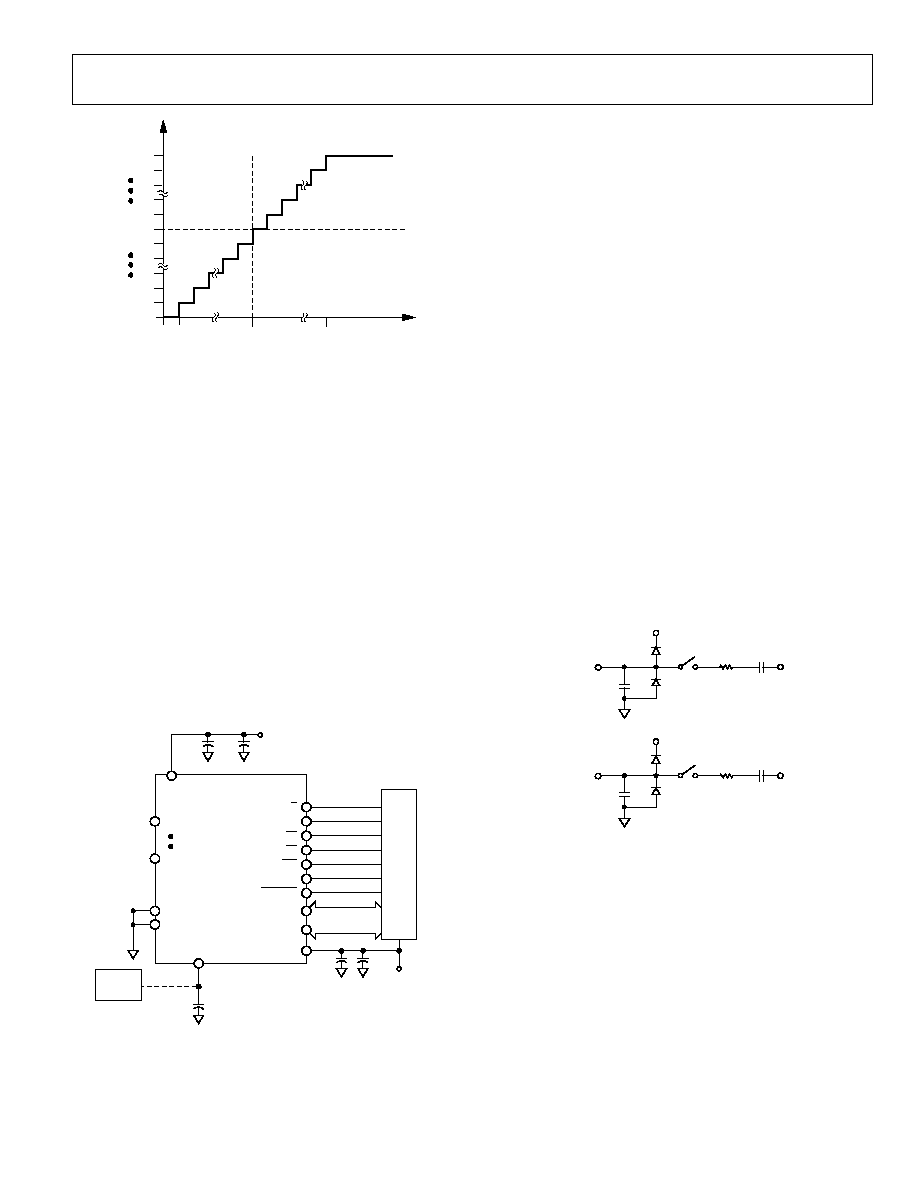
Preliminary Technical Data
AD7933/AD7934
ANALOG INPUT STRUCTURE
03713-0-026
100...000
011...111
1 LSB = 2
× V
REF
/4096 (AD7934)
1 LSB = 2
× V
REF
/1024 (AD7933)
V
REF
+ 1 LSB
V
REF
+V
REFV
1 LSB
ADC CODE
100...001
100...010
011...110
000...001
000...000
111...111
Figure 23 shows the equivalent circuit of the analog input
structure of the AD7933/AD7934 in differential/pseudo-
differential mode. In single-ended mode, V
IN-
is internally tied
to AGND. The four diodes provide ESD protection for the
analog inputs. Care must be taken to ensure that the analog
input signals never exceed the supply rails by more than
300 mV. This causes these diodes to become forward-biased and
start conducting into the substrate. These diodes can conduct
up to 10 mA without causing irreversible damage to the part.
The C1 capacitors, in Figure 23, are typically 4 pF and can
primarily be attributed to pin capacitance. The resistors are
lumped components made up of the on resistance of the
switches. The value of these resistors is typically about 100 .
The C2 capacitors, in Figure 23, are the ADC's sampling
capacitors and have a typical capacitance of 16 pF.
Figure 21. AD7933/AD7934 Ideal Transfer Characteristic
with Twos Complement Output Coding
TYPICAL CONNECTION DIAGRAM
Figure 22
Figure 22. Typical Connection Diagram
shows a typical connection diagram for the
AD7933/AD7934. The AGND and DGND pins are connected
together at the device for good noise suppression. The
V
REFIN
/V
REFOUT
pin is decoupled to AGND with a 0.47 µF
capacitor to avoid noise pickup, if the internal reference is used.
Alternatively, V
REFIN
/V
REFOUT
can be connected to a external
reference source, and in this case, the reference pin should be
decoupled with a 0.1 µF capacitor. In both cases, the analog
input range can either be 0 V to V
REF
(RANGE bit = 0) or 0 V to
2 × V
REF
(RANGE bit = 1). The analog input configuration is
either four single-ended inputs, two differential pairs or two
pseudo-differential pairs (see
). The V
DD
pin connects to
either a 3 V or 5 V supply. The voltage applied to the V
DRIVE
input controls the voltage of the digital interface, and here, it is
connected to the same 3 V supply of the microprocessor to
allow a 3 V logic interface (see the
section).
For ac applications, removing high frequency components from
the analog input signal is recommended by using an RC low-
pass filter on the relevant analog input pins. In applications
where harmonic distortion and signal-to-noise ratio are critical,
the analog input should be driven from a low impedance source.
Large source impedances significantly affect the ac performance
of the ADC. This may necessitate the use of an input buffer
amplifier. The choice of the op amp is a function of the
particular application.
R1
C2
V
IN
+
V
DD
C1
D
D
03713-0-028
R1
C2
V
IN
V
DD
C1
D
D
Table 9
Digital Inputs
03713-0-027
0.1
µF
10
µF
3V/5V
SUPPLY
3V
SUPPLY
µC/µP
AD7933/AD7934
0.1
µF
0.1
µF EXTERNAL V
REF
0.47
µF INTERNAL V
REF
0 TO V
REF
/
0 TO 2
× V
REF
AGND
DGND
W/B
CLKIN
CS
V
DRIVE
V
IN
0
V
DD
V
REFIN
/V
REFOUT
V
IN
3
10
µF
2.5V
V
REF
RD
CONVST
WR
BUSY
DB0
DB11/DB9
Figure 23. Equivalent Analog Input Circuit, Conversion Phase--Switches,
Open Track Phase--Switches Closed
When no amplifier is used to drive the analog input, the source
impedance should be limited to low values. The maximum
source impedance will depend on the amount of THD that can
be tolerated. The THD increases as the source impedance
increases and performance degrades. F
shows a graph of
the THD versus the analog input signal frequency for different
source impedances for both V
DD
= 5 V and 3 V.
igure 24
Rev. PrG | Page 19 of 32
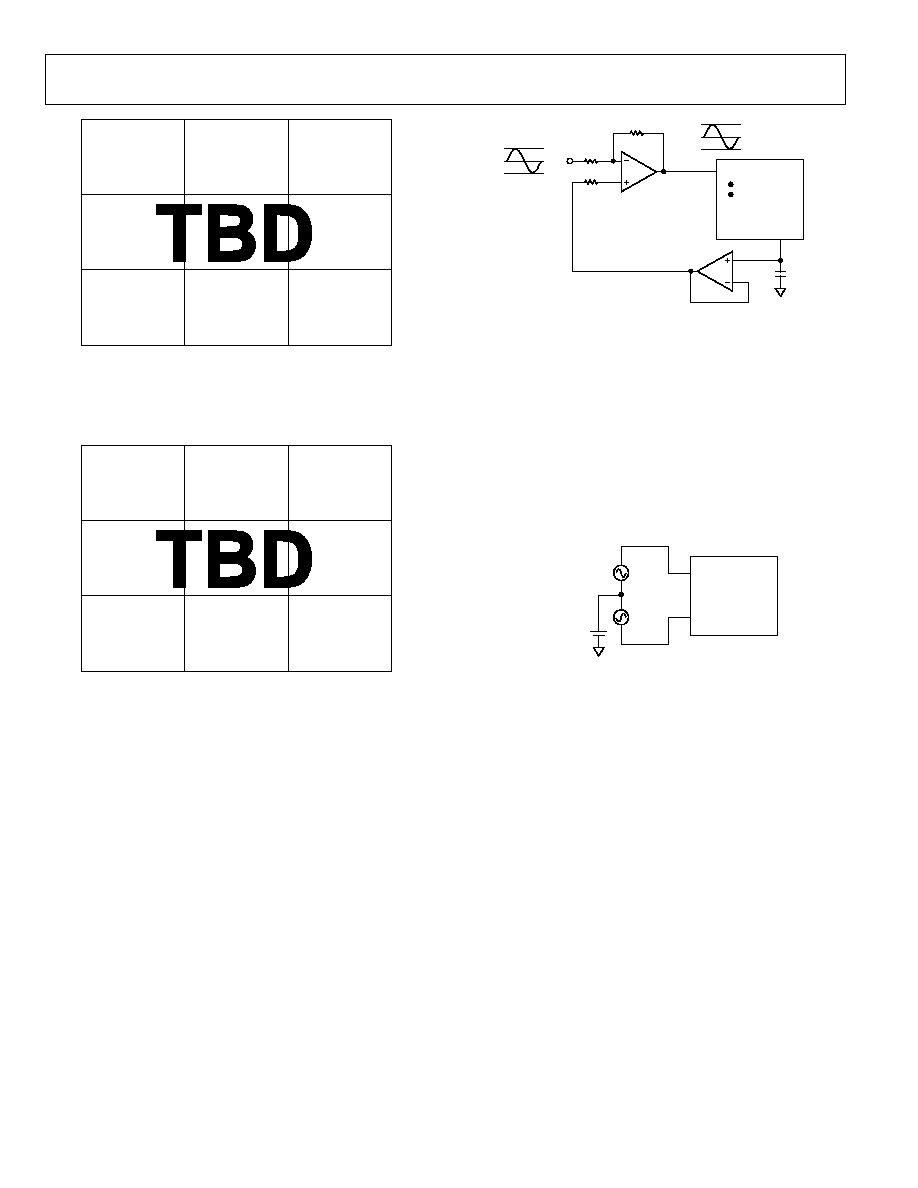
AD7933/AD7934
Preliminary Technical Data
0.47
µF
+1.25V
V
IN
R
R
3R
0V
1.25V
+2.5V
0V
V
IN0
V
IN3
V
REFOUT
AD7933/
AD7934*
*ADDITIONAL PINS OMITTED FOR CLARITY
03713-0-031
Figure 24. THD vs. Analog Input Frequency for Various Source Impedances
Figure 25 shows a graph of the THD versus the analog input
frequency for various supplies, while sampling at 1.5 MHz with
an SCLK of 20 MHz. In this case, the source impedance is 10 .
Figure 25. THD vs. Analog Input Frequency for Various Supply Voltages
ANALOG INPUTS
The AD7933/AD7934 have software selectable analog input
configurations. Users can choose either four single-ended
inputs, two fully differential pairs, or two pseudo-differential
pairs. The analog input configuration is chosen with Bits
MODE0/MODE1 in the internal control register (see
).
Table 9
Single-Ended Mode
The AD7933/AD7934 can have four single-ended analog input
channels by setting the MODE0 and MODE1 bits in the control
register both to 0. In applications where the signal source has a
high impedance, it is recommended to buffer the analog input
before applying it to the ADC. The analog input range is either 0
to V
REF
or 0 to 2 × V
REF
.
If the analog input signal to be sampled is bipolar, the internal
reference of the ADC can be used to externally bias up this
signal to make it of the correct format for the ADC.
Figure 26
Figure 26. Single-Ended Mode Connection Diagram
Differential Mode
The AD7933/AD7934 can have two differential analog input
pairs by setting Bits MODE0 and MODE1 in the control
register to 0 and 1, respectively.
Differential signals have some benefits over single-ended
signals, including noise immunity based on the device's
common-mode rejection and improvements in distortion
performance. F
defines the fully differential analog
input of the AD7933/AD7934.
igure 27
Figure 27. Differential Input Definition
03713-0-032
V
REF
p-p
V
IN+
V
IN
V
REF
p-p
*ADDITIONAL PINS OMITTED FOR CLARITY
AD7933/
AD7934*
COMMON-MODE
VOLTAGE
The amplitude of the differential signal is the difference
between the signals applied to the V
IN+
and V
IN-
pins in each
differential pair (i.e., V
IN+
- V
IN-
). V
IN+
and V
IN-
should be
simultaneously driven by two signals, each of amplitude V
REF
that are 180° out of phase. The amplitude of the differential
signal is therefore -V
REF
to +V
REF
peak-to-peak (i.e., 2 × V
REF
).
This is regardless of the common mode (CM). The common
mode is the average of the two signals, i.e. (V
IN+
+ V
IN-
)/2, and is
therefore the voltage that the two inputs are centered on. This
results in the span of each input being CM ± V
REF
/2. This
voltage has to be set up externally and its range varies with V
REF
.
As the value of V
REF
increases, the common-mode range
decreases. When driving the inputs with an amplifier, the actual
common-mode range is determined by the amplifier's output
voltage swing.
Figure 28 and Figure 29 show how the common-mode range
typically varies with V
REF
for both a 5 V and a 3 V power supply.
The common mode must be in this range to guarantee the
functionality of the AD7933/AD7934.
shows a typical connection diagram when operating
the ADC in single-ended mode.
Rev. PrG | Page 20 of 32
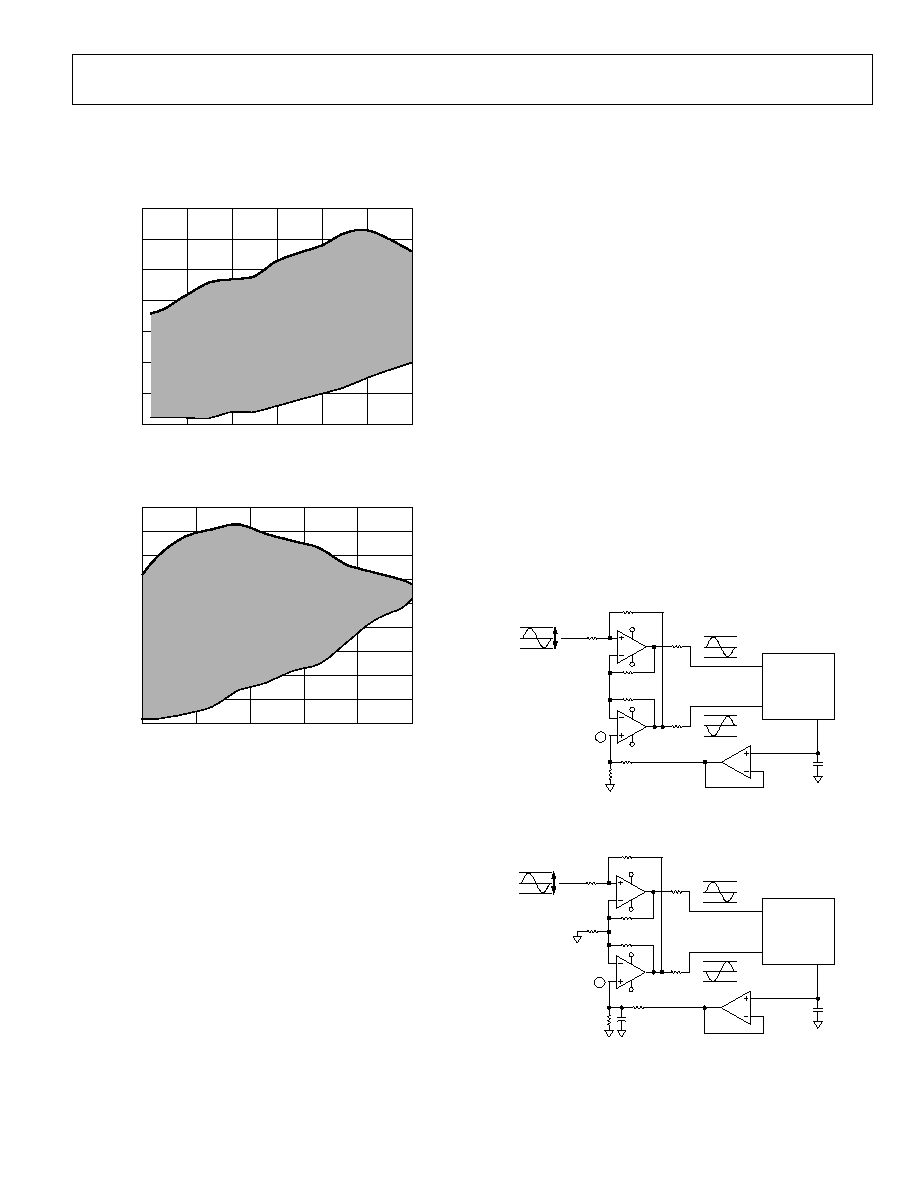
Preliminary Technical Data
AD7933/AD7934
Using an Op Amp Pair
When a conversion takes place, the common mode is rejected
resulting in a virtually noise free signal of amplitude -V
REF
to
+V
REF
corresponding to the digital codes of 0 to 1024 for the
AD7933 and 0 to 4096 for the AD7934.
An op amp pair can be used to directly couple a differential
signal to one of the analog input pairs of the AD7933/AD7934.
The circuit configurations shown in
and
show how a dual op amp can be used to convert a single-ended
signal into a differential signal for both a bipolar and unipolar
input signal, respectively.
Figure 30
Figure 30
Figure 30
Figure 30. Dual Op Amp Circuit to Convert a
Single-Ended Unipolar Signal into a Differential Signal
Figure 31
Figure 31
Figure 31
Figure 31. Dual Op Amp Circuit to Convert a
Single-Ended Bipolar Signal into a Differential Signal
V
REF
(V)
COMMON-MODE
RANGE
(V
)
3.5
3.0
2.0
1.5
2.5
1.0
0.5
0
0
0.5
1.5
1.0
2.0
2.5
3.0
03713-0-033
The voltage applied to Point A sets up the common-mode
voltage. In both diagrams, it is connected in some way to the
reference, but any value in the common-mode range can be
input here to set up the common mode. A suitable dual op amp
that could be used in this configuration to provide differential
drive to the AD7933/AD7934 is the AD8022.
Take care when choosing the op amp; the selection depends on
the required power supply and system performance objectives.
The driver circuits in
and
are optimized for
dc coupling applications requiring best distortion performance.
Figure 28. Input Common-Mode Range vs.
V
REF
(0 to V
REF
Range, V
DD
= 5 V)
The circuit configuration shown in
converts a
unipolar, single-ended signal into a differential signal.
V
REF
(V)
COMMON-MODE
RANGE
(V
)
4.5
4.0
3.0
1.5
2.0
2.5
3.5
1.0
0.5
0
0.1
0.6
1.6
1.1
2.1
2.6
03713-0-034
The circuit configuration in
is configured to convert
and level shift a single-ended, ground-referenced (bipolar)
signal to a differential signal centered at the V
REF
level of the
ADC.
2
×
V
REF
p-p
V
REF
GND
390
220
220
20k
220
10k
27
27
V+
V
V+
V
A
V
IN+
V
IN
V
REF
AD7933/
AD7934
0.47
µF
03713-
0-
035
3.75V
2.5V
1.25V
3.75V
2.5V
1.25V
Figure 29. Input Common-Mode Range vs.
V
REF
(2 × V
REF
Range, V
DD
= 5 V)
Driving Differential Inputs
Differential operation requires that V
IN+
and V
IN-
be
simultaneously driven with two equal signals that are 180° out
of phase. The common mode must be set up externally and
have a range that is determined by V
REF
, the power supply, and
the particular amplifier used to drive the analog inputs.
Differential modes of operation with either an ac or dc input
provide the best THD performance over a wide frequency
range. Since not all applications have a signal preconditioned for
differential operation, there is often a need to perform single-
ended-to-differential conversion.
2
×
V
REF
p-p
GND
390
220
220
220
20k
220
10k
27
27
V+
V
V+
V
A
V
IN+
V
IN
V
REF
AD7933/
AD7934
0.47
µF
03713-
0-
036
3.75V
2.5V
1.25V
3.75V
2.5V
1.25V
Rev. PrG | Page 21 of 32
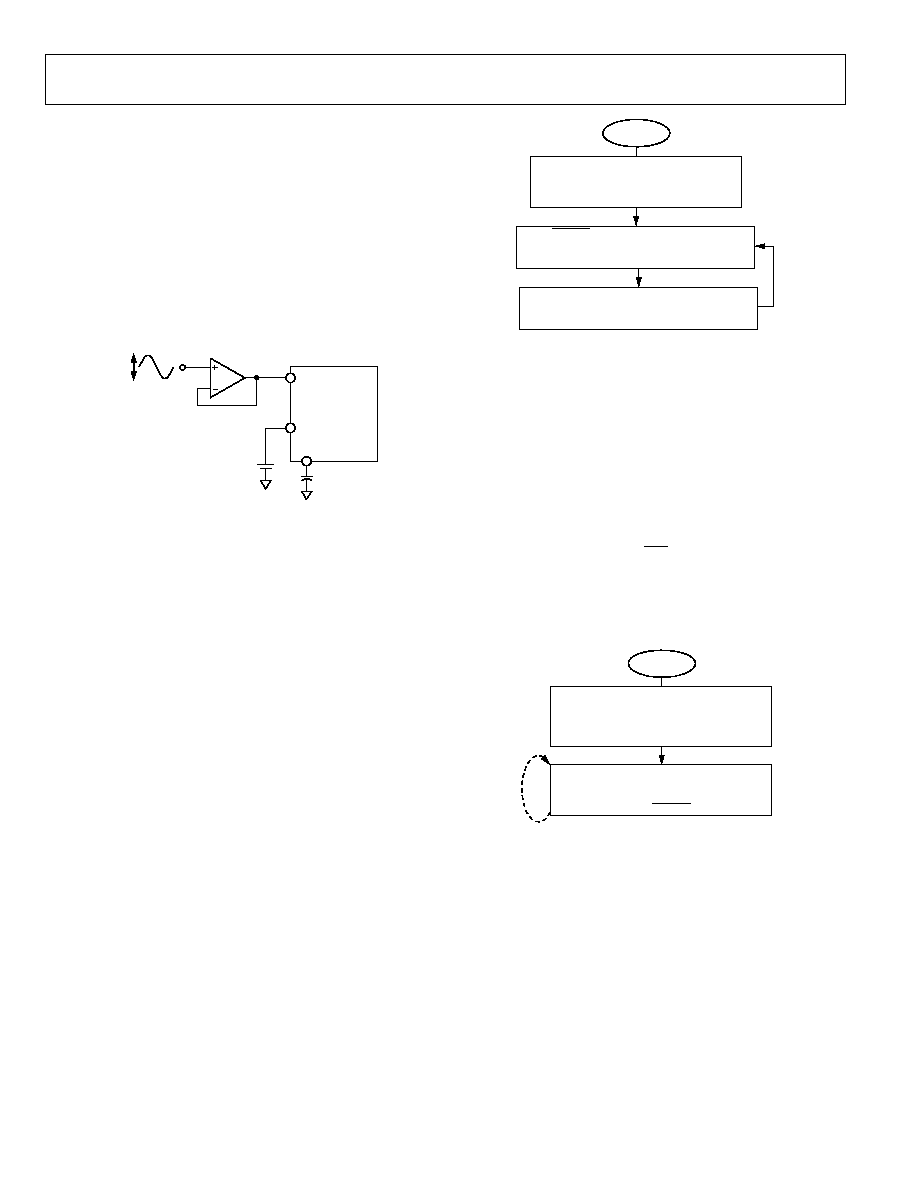
AD7933/AD7934
Preliminary Technical Data
POWER ON
WRITE TO THE CONTROL REGISTER TO
SET UP OPERATING MODE, ANALOG INPUT
AND OUTPUT CONFIGURATION
SET SEQ0 = SEQ1 = 0. SELECT THE DESIRED
CHANNEL TO CONVERT ON (ADD1 TO ADD0).
ISSUE CONVST PULSE TO INITIATE A CONVERSION
ON THE SELECTED CHANNEL.
INITIATE A READ CYCLE TO READ THE DATA
FROM THE SELECTED CHANNEL.
INITIATE A WRITE CYCLE TO SELECT THE NEXT
CHANNEL TO BE CONVERTED ON BY
CHANGING THE VALUES OF BITS ADD2 TO ADD0
IN THE CONTROL REGISTER. SEQ0 = SEQ1 = 0.
03713-0-038
Pseudo-Differential Mode
The AD7933/AD7934 can have two pseudo-differential pairs by
setting Bits MODE0 and MODE1 in the control register to 1, 0,
respectively. V
IN
+ is connected to the signal source that must
have an amplitude of V
REF
to make use of the full dynamic range
of the part. ADC input is applied to the V
IN-
pin. The voltage
applied to this input provides an offset from ground or a pseudo
ground for the V
IN
+ input. The benefit of pseudo-differential
inputs is that they separate the analog input signal ground from
the ADC's ground allowing dc common-mode voltages to be
cancelled. Figure 32 shows a connection diagram for the
pseudo-differential mode.
V
IN+
V
IN
V
REF
AD7933/
AD7934*
*ADDITIONAL PINS OMITTED FOR CLARITY
03713-0-037
V
REF
p-p
0.47
µF
DC INPUT
VOLTAGE
RANGE
±100mV
Figure 32. Pseudo-Differential Mode Connection Diagram
ANALOG INPUT SELECTION
As shown in
, users can set up their analog input
configuration by setting the values in Bits MODE0 and MODE1
in the control register. Assuming the configuration is chosen,
there are two different ways of selecting the analog input to be
converted depending on the state of the SEQ0 and SEQ1 bits in
the control register.
Table 9
Table 9
Normal Multichannel Operation (SEQ0 = SEQ1 = 0)
Any one of four analog input channels or two pairs of channels
may be selected for conversion in any order by setting the SEQ0
and SEQ1 bits in the control register both to 0. The channel to
be converted is selected by writing to Bits ADD1 and ADD0 in
the control register to program the multiplexer prior to the
conversion. This mode of operation is of a normal multichannel
ADC where each data write selects the next channel for
conversion. F
shows a flow chart of this mode of
operation. The channel configurations are shown in
.
igure 33
Figure 33. Normal Multichannel Operation Flow Chart
Using the Sequencer: Consecutive Sequence (SEQ0 = 1,
SEQ1 = 1)
A sequence of consecutive channels can be converted beginning
with Channel 0 and ending with a final channel selected by
writing to Bits ADD1 and ADD0 in the control register. This is
done by setting the SEQ0 and SEQ1 bits in the control register
both to 1. Once the control register is written to set this mode
up, the next conversion is on Channel 0, then Channel 1, and so
on until the channel selected by the address bits, ADD1 and
ADD0, is reached. The ADC then returns to Channel 0 and
starts the sequence again. The WR input must be kept high to
ensure that the control register is not accidentally overwritten
and the sequence interrupted. This pattern continues until such
time as the AD7933/AD7934 is written to. F
shows the
flow chart of the consecutive sequence mode.
igure 34
Figure 34. Consecutive Sequence Mode Flow Chart
POWER ON
WRITE TO THE CONTROL REGISTER TO
SET UP OPERATING MODE, ANALOG INPUT
AND OUTPUT CONFIGURATION SELECT
FINAL CHANNEL (ADD1 AND ADD0) IN
CONSECUTIVE SEQUENCE.
SET SEQ0 = 1 SEQ1 = 1.
CONTINUOUSLY CONVERT ON A CONSECUTIVE
SEQUENCE OF CHANNELS FROM CHANNEL 0
UP TO AND INCLUDING THE PREVIOUSLY
SELECTED FINAL CHANNEL ON ADD1 AND ADD0
WITH EACH CONVST PULSE.
03713-0-039
REFERENCE SECTION
The AD7933/AD7934 can operate with either the on-chip
reference or an external reference. The internal reference is
selected by setting the REF bit in the internal control register to 1.
A block diagram of the internal reference circuitry is shown in
Figure 35. The internal reference circuitry includes an on-chip
2.5 V band gap reference and a reference buffer. When using the
internal reference, the V
REFIN
/V
REFOUT
pin should be decoupled to
AGND with a 0.47 µF capacitor. This internal reference not only
provides the reference for the analog-to-digital conversion, but it
also is used externally in the system. It is recommended that the
reference output is buffered using an external precision op amp
before applying it anywhere in the system.
Rev. PrG | Page 22 of 32
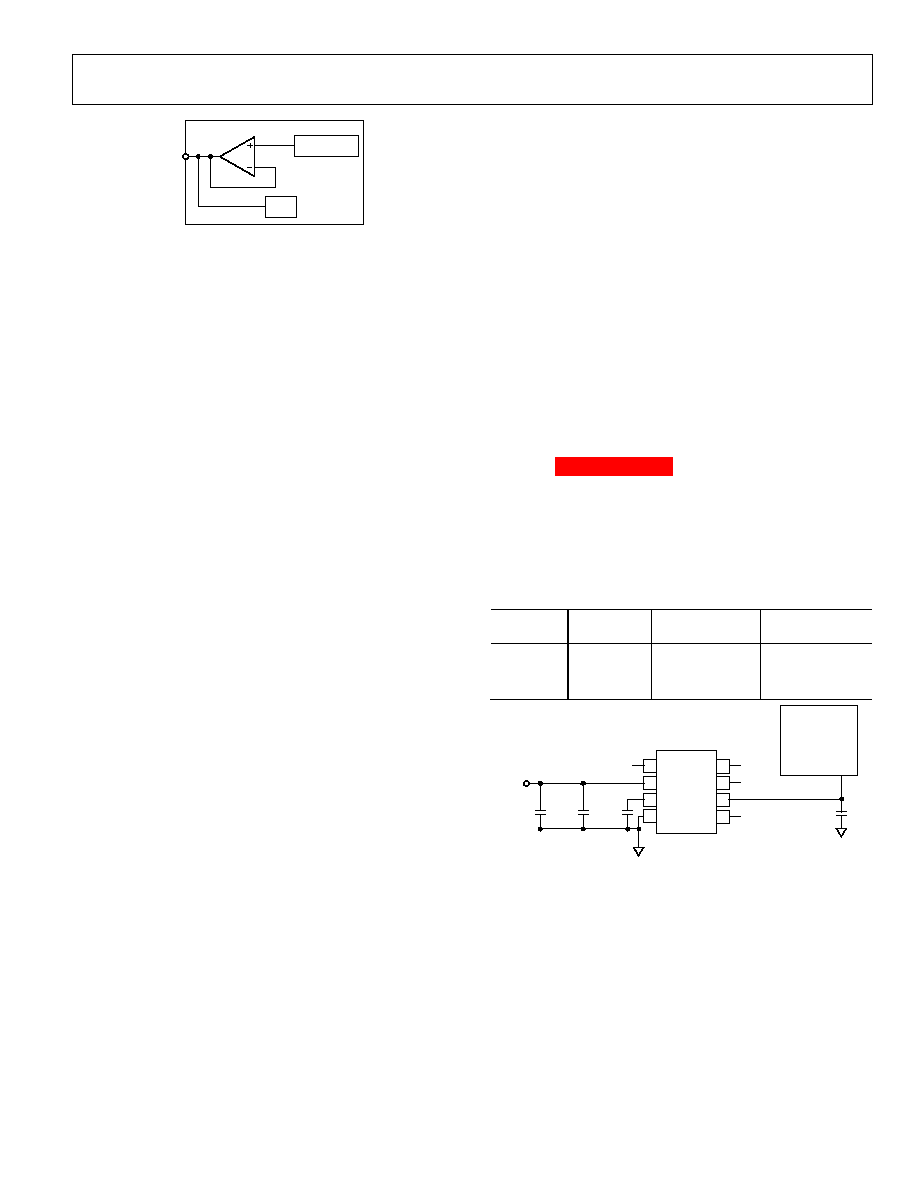
Preliminary Technical Data
AD7933/AD7934
REFERENCE
AD7933/
AD7934
ADC
BUFFER
03713-0-040
V
REFIN
/
V
REFOUT
Example 2
V
IN MAX
= V
DD
+ 0.3
V
IN MAX
= V
REF
+ V
REF
/2
If V
DD
= 3.6 V, then V
IN MAX
= 3.9 V.
Figure 35. Internal Reference Circuit Block Diagram
Therefore, 3 × V
REF
/2 = 3.6 V.
Alternatively, an external reference can be applied to the
V
REFIN
/V
REFOUT
pin of the AD7933/AD7934. An external
reference input is selected by setting the REF bit in the internal
control register to 0. When using an external reference, the
V
REFIN
/V
REFOUT
pin should be decoupled to AGND with a 0.1 µF
capacitor. When operating in differential mode, the external
reference input range is 0.1 V to 3.5V, and in single-ended and
pseudo-differential mode, the external reference input range is
0.1 V to V
DD
. In all cases, the specified reference is 2.5 V.
V
REF
MAX
= 2.6 V
Therefore, when operating with at V
DD
= 3 V, the value of V
REF
can range from 100 mV to a maximum value of 2.4 V. When
V
DD
= 2.7 V, V
REF
MAX
= 2 V.
These examples show that the maximum reference applied to
the AD7933/AD7934 is directly dependant on the value applied
to V
DD
.
It is important to ensure that, when choosing the reference
value, the maximum analog input range (V
IN MAX
) is never
greater than V
DD
+ 0.3 V to comply with the maximum ratings
of the device. In pseudo differential mode, the user must ensure
that V
REFIN
- V
IN-
V
DD
.
The performance of the part at different reference values is
shown in Figures TBD to TBD. The value of the reference sets
the analog input span and the common-mode voltage range.
Errors in the reference source result in gain errors in the
AD7933/AD7934 transfer function and add to the specified
full-scale errors on the part.
lists suitable voltage
references available from ADI that could be used, and F
shows a typical connection diagram for an external reference.
Table 11
Table 11. Examples of Suitable Voltage References
The following two examples calculate the maximum V
REF
input
that can be used when operating the AD7933/AD7934 in
differential mode with a V
DD
of 5 V and 3 V, respectively.
igure 36
Figure 36. Typical V
REF
Connection Program
Example 1
Reference
Output
Voltage
Initial Accuracy
(% max)
Operating
Current (µA)
AD780
2.5/3
0.04
1000
ADR421 2.5
0.04
500
ADR420 2.048
0.05
500
V
IN MAX
= V
DD
+ 0.3
V
IN MAX
= V
REF
+ V
REF
/2
03713-0-041
1
AD780
NC
8
2
+V
IN
NC
7
3
GND
6
4
TEMP
5
O/PSELECT
TRIM
V
OUT
V
REF
2.5V
NC
NC
V
DD
NC = NO CONNECT
10nF
0.1
µF
0.1
µF
0.1
µF
*ADDITIONAL PINS OMITTED FOR CLARITY
AD7933/
AD7934*
If V
DD
= 5 V, then V
IN MAX
= 5.3 V.
Therefore, 3 × V
REF
/2 = 5.3 V.
V
REF
MAX
= 3.5 V
Therefore, when operating at V
DD
= 5 V, the value of V
REF
can
range from 100 mV to a maximum value of 3.5 V. When V
DD
=
4.75 V, V
REF
MAX
= 3.17 V.
Rev. PrG | Page 23 of 32
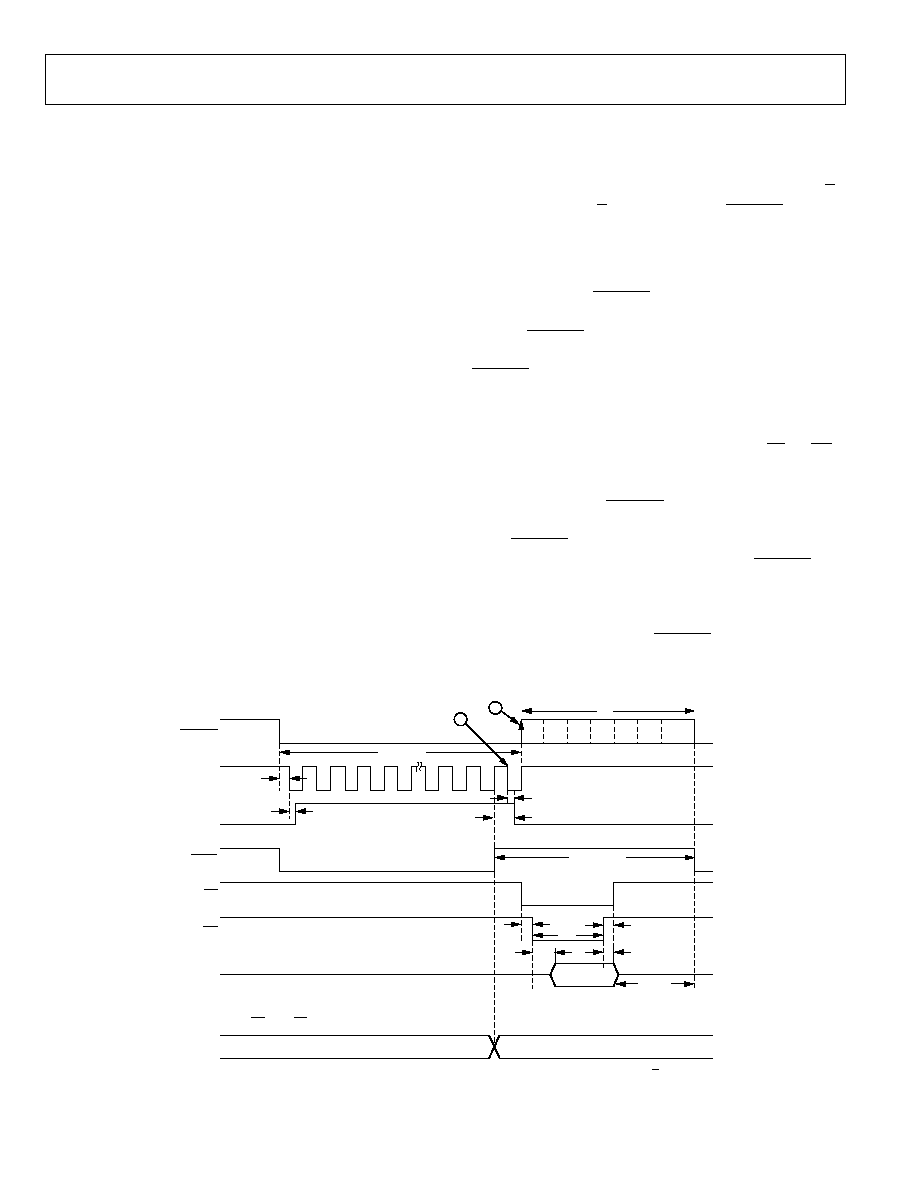
AD7933/AD7934
Preliminary Technical Data
Digital Inputs
PARALLEL INTERFACE
The digital inputs applied to the AD7933/AD7934 are not
limited by the maximum ratings that limit the analog inputs.
Instead, the digital inputs applied can go to 7 V and are not
restricted by the AV
DD
+ 0.3 V limit that is on the analog inputs.
The AD7933/AD7934 have a flexible, high speed, parallel
interface. This interface is 12-bits (AD7934) or 10-bits
(AD7933) wide and is capable of operating in either word (W/B
tied high) or byte (W/B tied low) mode. The CONVST signal is
used to initiate conversions, and when operating in auto
shutdown or auto standby mode, it is used to power up the
ADC.
Another advantage of the digital inputs not being restricted by
the AV
DD
+ 0.3 V limit is the fact that power supply sequencing
issues are avoided. If any of these inputs are applied before AV
DD
,
then there is no risk of latch-up as there would be on the analog
inputs if a signal greater than 0.3 V was applied prior to AV
DD
.
A falling edge on the CONVST signal is used to initiate
conversions, and it also puts the ADC track-and-hold into track.
Once the CONVST signal goes low, the BUSY signal goes high
for the duration of the conversion. In between conversions,
CONVST must be brought high for a minimum time of t
1
. This
must happen after the 14
th
rising edge of CLKIN; otherwise, the
conversion will be aborted and the track-and-hold will go back
into track. At the end of the conversion, BUSY goes low and can
be used to activate an interrupt service routine. The CS and RD
lines are then activated in parallel to read the 12 bits or 10 bits
of conversion data. When power supplies are first applied to the
device, a rising edge on CONVST puts the track-and-hold into
track. The acquisition time of 135 ns minimum must be allowed
before CONVST is brought low to initiate a conversion. The
ADC will then go into hold on the falling edge of CONVST and
back into track on the 13
th
rising edge of CLKIN after this (see
). When operating the device in auto shutdown or auto
standby mode, where the ADC powers down at the end of each
conversion, a rising edge on the CONVST signal is used to
power up the device.
V
DRIVE
Input
The AD7933/AD7934 has a V
DRIVE
feature. V
DRIVE
controls the
voltage at which the parallel interface operates. V
DRIVE
allows the
ADC to easily interface to 1.8 V, 3 V, and 5 V processors. V
DRIVE
of 1.8 V can only be used if V
DD
= 2.7 V to 3.6 V.
For example, if the AD7933/AD7934 operated with an AV
DD
of
5 V and the V
DRIVE
pin could be powered from a 3 V supply, the
AD7933/AD7934 has better dynamic performance with an
AV
DD
of 5 V while still being able to interface to 3 V processors.
Care should be taken to ensure V
DRIVE
does not exceed AV
DD
by
more than 0.3 V (see
).
Table 4
Figure 37
Figure 37. AD7933/AD7934 Parallel Interface--Conversion and Read Cycle in Word Mode (W/B = 1)
t
2
t
3
t
20
t
14
t
11
t
9
t
13
t
12
t
10
t
CONVERT
t
AQUISITION
t
QUIET
t
1
1
2
3
4
5
12
13
14
B
A
DATA
DATA
OLD DATA
DB0 TO DB11
DB0 TO DB11
RD
CS
INTERNAL
TRACK/HOLD
BUSY
CLKIN
CONVST
THREE-STATE
THREE-STATE
03713-0-004
WITH CS AND RD TIED LOW
Rev. PrG | Page 24 of 32
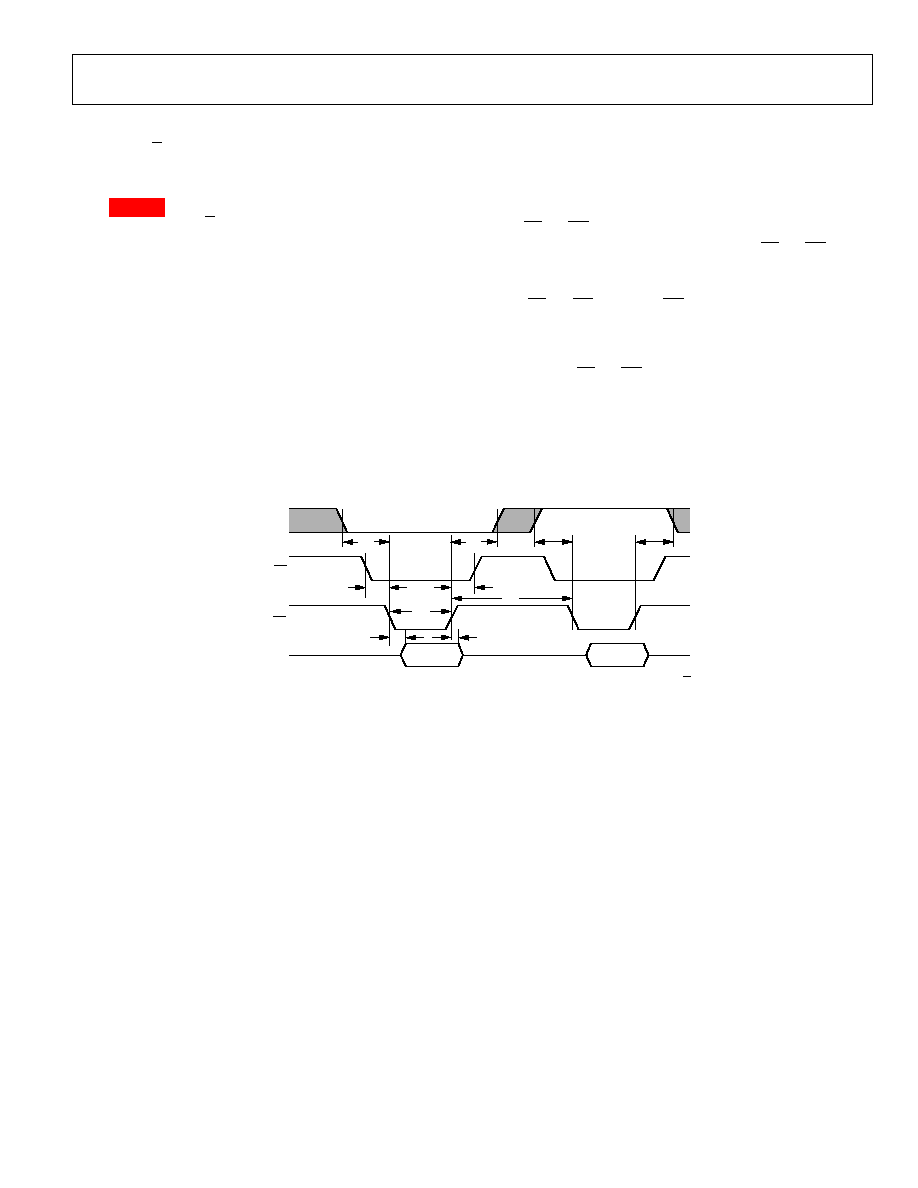
AD7933/AD7934
Preliminary Technical Data
Reading Data from the AD7933/AD7934
With the W/B pin tied logic high, the AD7933/AD7934
interface operates in word mode. In this case, a single read
operation from the device accesses the conversion data-word on
Pins DB0/DB2 to DB11. The DB8/HBEN pin assumes its DB8
function. With the W/B pin tied to logic low, the
AD7933/AD7934 interface operates in byte mode. In this case,
the DB8/HBEN pin assumes its HBEN function. Conversion
data from the AD7933/ AD7934 must be accessed in two read
operations with 8 bits of data provided on DB0 to DB7 for each
of the read operations. The HBEN pin determines whether the
read operation accesses the high byte or the low byte of the12-
or 10-bit word. For a low byte read, DB0 to DB7 provide the
eight LSBs of the 12-bit word. For 10-bit operation, the two
LSBs of the low byte are 0s and are followed by 6 bits of
conversion data. For a high byte read, DB0 to DB3 provide the
4 MSBs of the 12-/10-bit word. DB4 of the high byte is always 0
and DB5 and DB6 of the high byte provide the Channel ID.
shows the read cycle timing diagram for a 12-/10-bit
transfer. When operated in word mode, the HBEN input does
not exist and only the first read operation is required to access
data from the device. When operated in byte mode, the two read
cycles shown in F
are required to access the full data-
word from the device.
Figure 37
igure 38
Figure 38. AD7933/AD7934 Parallel Interface--Read Cycle Timing for Byte Mode Operation (W/B = 0)
The CS and RD signals are gated internally and level triggered
active low. In either word mode or byte mode, CS and RD may
be tied together as the timing specification t
10
and t
11
is 0 ns
minimum. The data is placed onto the data bus a time t
13
after
both CS and RD go low. The RD rising edge can be used to latch
data out of the device. After a time, t
14
, the data lines will
become three-stated.
Alternatively, CS and RD can be tied permanently low and the
conversion data will be valid and placed onto the data bus a
time, t
9
, before the falling edge of BUSY.
t
11
t
10
t
13
t
15
t
15
t
16
t
16
t
14
t
12
t
17
LOW BYTE
HIGH BYTE
DB0 TO DB7
HBEN/DB8
RD
CS
03713-0-005
Rev. PrG | Page 25 of 32
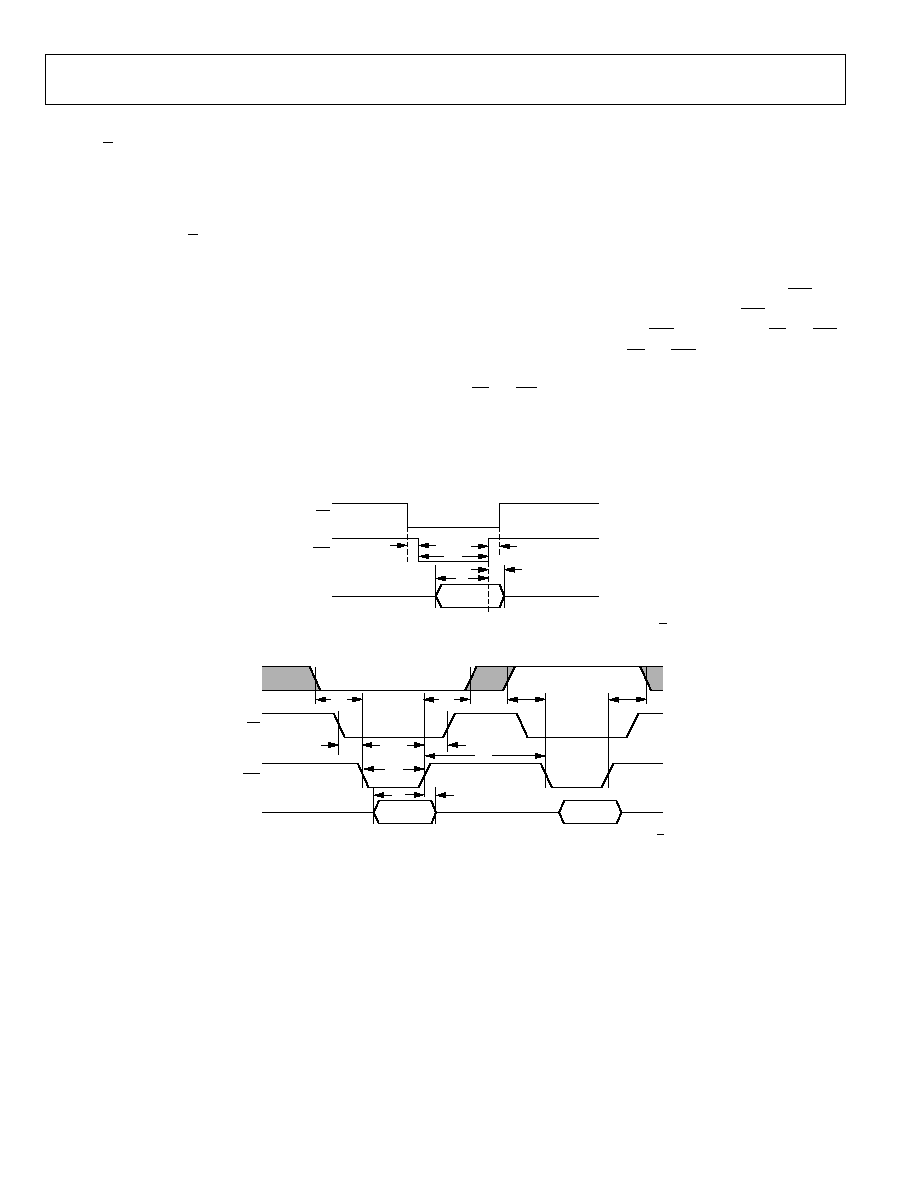
AD7933/AD7934
Preliminary Technical Data
Writing Data to the AD7933/AD7934
With W/B tied logic high, a single write operation transfers the
full data-word on DB0 to DB11 to the control register on the
AD7933/AD7934. The DB8/HBEN pin assumes its DB8
function. Data written to the AD7933/AD7934 should be
provided on the DB0 to DB11 inputs with DB0 being the LSB of
the data-word. With W/B tied logic low, the AD7933/AD7934
requires two write operations to transfer a full 12-bit word.
DB8/HBEN assumes its HBEN function. Data written to the
AD7933/AD7934 should be provided on the DB0 to DB7
inputs. HBEN determines whether the byte written is high byte
or low byte data. The low byte of the data-word has DB0 being
the LSB of the full data-word. For the high byte write, HBEN
should be high and the data on the DB0 input should be data bit
8 of the 12 bit word.
Figure 39
Figure 39. AD7933/AD7934 Parallel Interface--Write Cycle Timing for Word Mode Operation (W/B = 1)
shows the write cycle timing diagram of the
AD7933/AD7934. When operated in word mode, the HBEN
input does not exist and only the one write operation is required
to write the word of data to the device. Data should be provided
on DB0 to DB11. When operated in byte mode, the two write
cycles shown in F
are required to write the full data-
word to the AD7933/AD7934. In F
, the first write
transfers the lower 8 bits of the data-word from DB0 to DB7
and the second write transfers the upper 4 bits of the data-word.
igure 40
igure 40
Figure 40. AD7933/AD7934 Parallel Interface--Write Cycle Timing for Byte Mode Operation (W/B = 0)
When writing to the AD7933/AD7934, the top 4 bits in the high
byte must be 0s.
The data is latched into the device on the rising edge of WR.
The data needs to be setup a time, t
7
, before the WR rising edge
and held for a time, t
8
, after the WR rising edge. The CS and WR
signals are gated internally. CS and WR may be tied together as
the timing specification for t
4
and t
5
is 0 ns minimum (assuming
CS and RD have not already been tied together).
t
8
t
5
t
7
t
6
t
4
DATA
DB0 TO DB11
WR
CS
03713-0-002
t
5
t
4
t
7
t
18
t
18
t
19
t
19
t
8
t
6
t
17
LOW BYTE
HIGH BYTE
DB0 TO DB7
HBEN/DB8
WR
CS
03713-0-003
Rev. PrG | Page 26 of 32
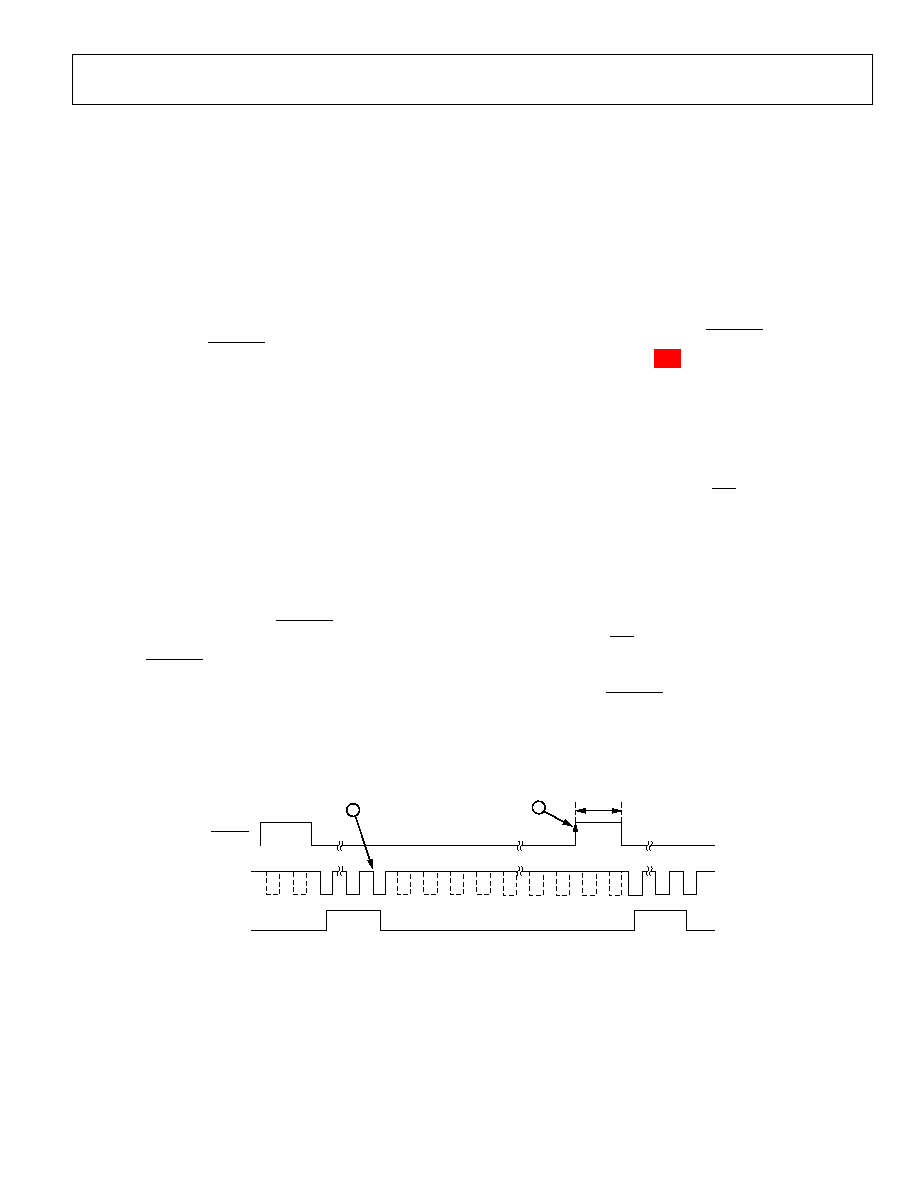
Preliminary Technical Data
AD7933/AD7934
POWER MODES OF OPERATION
The AD7933/AD7934 have four different power modes of
operation. These modes are designed to provide flexible power
management options. Different options can be chosen to
optimize the power dissipation/throughput rate ratio for
differing applications. The mode of operation is selected by the
power management bits, PM1 and PM0, in the control register,
as detailed in
. When power is first applied to the
AD7933/AD7934 an on-chip, power-on reset circuit ensures the
default power-up condition is normal mode.
Table 8
Note that, after power-on, track-and-hold is in hold mode and
the first rising edge of CONVST places the track-and-hold into
track mode.
Normal Mode (PM1 = PM0 = 0)
This mode is intended for the fastest throughput rate
performance because the user does not have to worry about any
power-up times because the AD7933/AD7934 remain fully
powered up at all times. At power-on reset, this mode is the
default setting in the control register.
Auto Shutdown (PM1 = 0; PM0 = 1)
In this mode of operation, the AD7933/AD7934 automatically
enter full shutdown at the end of each conversion, which is
shown at Point A in
. In shutdown mode, all internal
circuitry on the device is powered. The part retains information
in the control register during shutdown. It remains in shutdown
mode until the next rising edge of CONVST (see Point B in
). In order to keep the device in shutdown for as long
as possible, CONVST should idle low between conversions as
shown in
. On this rising edge, the part begins to
power-up and track-and-hold returns to track mode. The
power-up time required depends on whether the user is
operating with the internal or external reference. With the
internal reference, the power-up time is typically TBD, and with
an external reference, the power-up time is typically TBD. The
user should ensure that the power-up time has elapsed before
initiating a conversion.
Figure 37
Figure 37
Figure 41
Figure 41
Figure 41. Auto-Shutdown/Auto-Standby Mode
Auto Standby (PM1 = 1; PM0 = 0)
In this mode of operation, the AD7933/AD7934 automatically
enter standby mode at the end of each conversion. When this
mode is entered, all circuitry on the AD7933/AD7934 is
powered down except for the reference and reference buffer.
Also, track-and-hold goes into hold at this point and remains in
hold as long as the device is in standby The part remains in
standby until the next rising edge of CONVST powers up the
device, which takes at least TBD. The user should ensure this
power-up time has elapsed before initiating another conversion,
as shown in
. This rising edge of CONVST also places
track-and-hold back into track mode.
Full Shutdown Mode (PM1 = 1; PM0 = 1)
When this mode is entered, all circuitry on the
AD7933/AD7934 is powered down upon completion of the
write operation, i.e., on rising edge of WR. The part retains the
information in the control register while the part is in
shutdown. The AD7933/AD7934 remain in full shutdown
mode, and track-and-hold in hold mode, until the power
management bits (PM1 and PM0) in the control register are
changed. If a write to the control register occurs while the part
is in full shutdown mode, and the power management bits are
changed to PM0 = PM1 = 0, i.e., normal mode, the part begins
to power up on the WR rising edge and the track and hold
returns to track.. To ensure the part is fully powered up before a
conversion is initiated, the power-up time, TBD, should be
allowed before the CONVST falling edge; otherwise, invalid
data is read.
t
POWER-UP
1
1
14
14
BUSY
CLKIN
CONVST
03713-0-048
A
B
Rev. PrG | Page 27 of 32
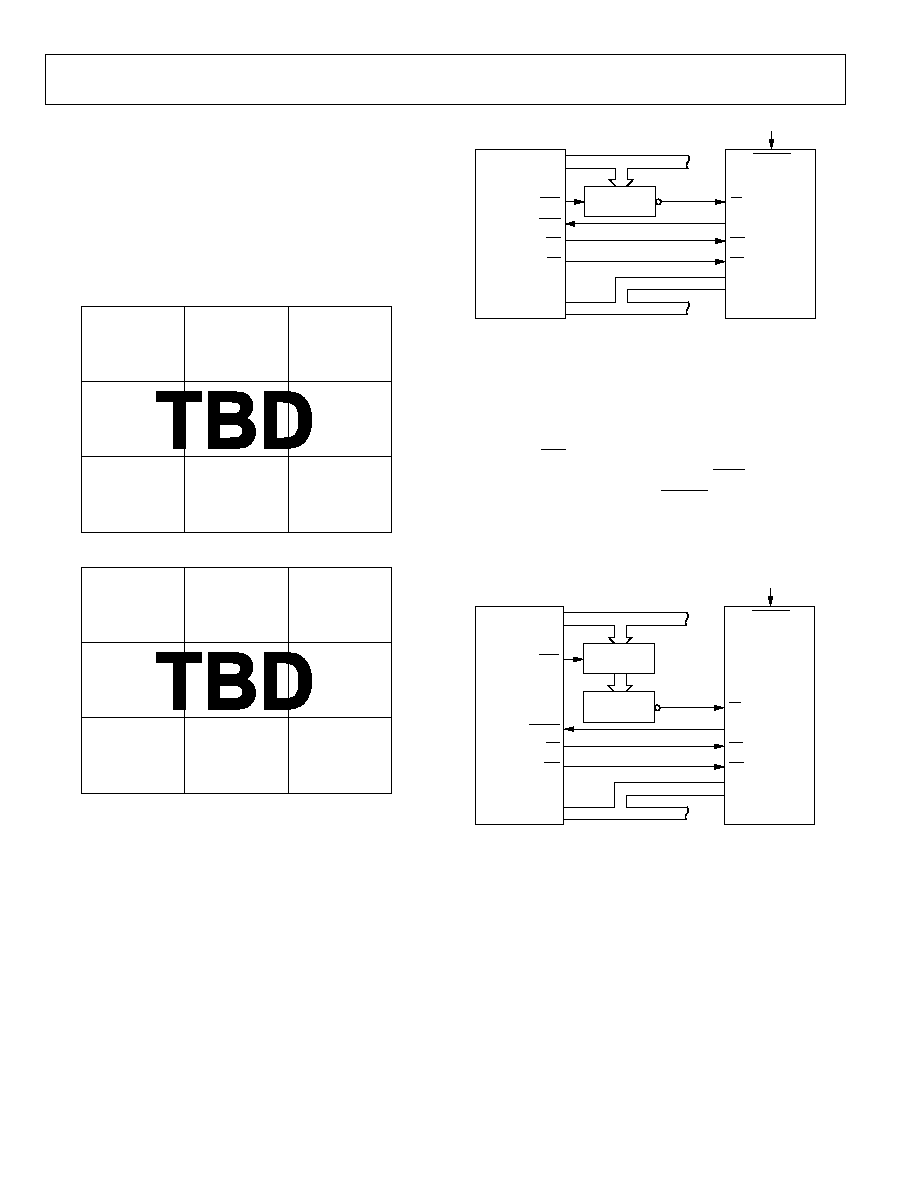
AD7933/AD7934
Preliminary Technical Data
POWER VS. THROUGHPUT RATE
A big advantage of powering the ADC down after a conversion
is that the power consumption of the part is significantly
reduced at lower throughput rates. When using the different
power modes, the AD7933/AD7934 is only powered up for the
duration of the conversion. Therefore, the average power
consumption per cycle is significantly reduced. F
and
show plots of the power versus the throughput when
operating in auto shutdown and auto standby modes.
igure 42
Figure 42. Power vs. Throughput in Auto Shutdown Mode
Figure 43
Figure 43. Power vs. Throughput in Auto Standby Mode
MICROPROCESSOR INTERFACING
AD7933/AD7934 to ADSP-21xx Interface
Figure 44
Figure 44. Interfacing to the ADSP-21xx
shows the AD7933/AD7934 interfaced to the ADSP-
21xx series of DSPs as a memory mapped device. A single wait
state may be necessary to interface the AD7933/AD7934 to the
ADSP-21xx, depending on the clock speed of the DSP. The wait
state can be programmed via the data memory wait state
control register of the ADSP-21xx (see the ADSP-21xx family
User's Manual for details). The following instruction reads from
the AD7933/AD7934:
MR = DM (ADC)
where ADC is the address of the AD7933/AD7934.
AD7933/
AD7934*
ADSP-21xx*
WR
RD
DB0 TO DB11
D0 TO D23
A0 TO A15
DMS
IRQ2
BUSY
CS
CONVST
OPTIONAL
WR
RD
*ADDITIONAL PINS OMITTED FOR CLARITY
ADDRESS BUS
DATA BUS
ADDRESS
DECODER
03713-0-044
AD7933/AD7934 to ADSP-21065L Interface
Figure 45
Figure 45. Interfacing to the ADSP-21065L
shows a typical interface between the
AD7933/AD7934 and the ADSP-21065L SHARC processor.
This interface is an example of one of three DMA handshake
modes. The MS
x
control line is actually three memory select
lines. Internal ADDR
2524
are decoded into MS
3-0
, these lines are
then asserted as chip selects. The DMAR
1
(DMA request 1) is
used in this setup as the interrupt to signal the end of the
conversion. The rest of the interface is standard handshaking
operation.
AD7933/
AD7934*
ADSP-21065L*
WR
DB0 TO DB11
D0 TO D31
ADDR
0
TO ADDR
23
MS
X
DMAR
1
BUSY
CS
CONVST
OPTIONAL
WR
RD
RD
*ADDITIONAL PINS OMITTED FOR CLARITY
ADDRESS BUS
ADDRESS BUS
DATA BUS
ADDRESS
LATCH
ADDRESS
DECODER
03713-0-045
Rev. PrG | Page 28 of 32
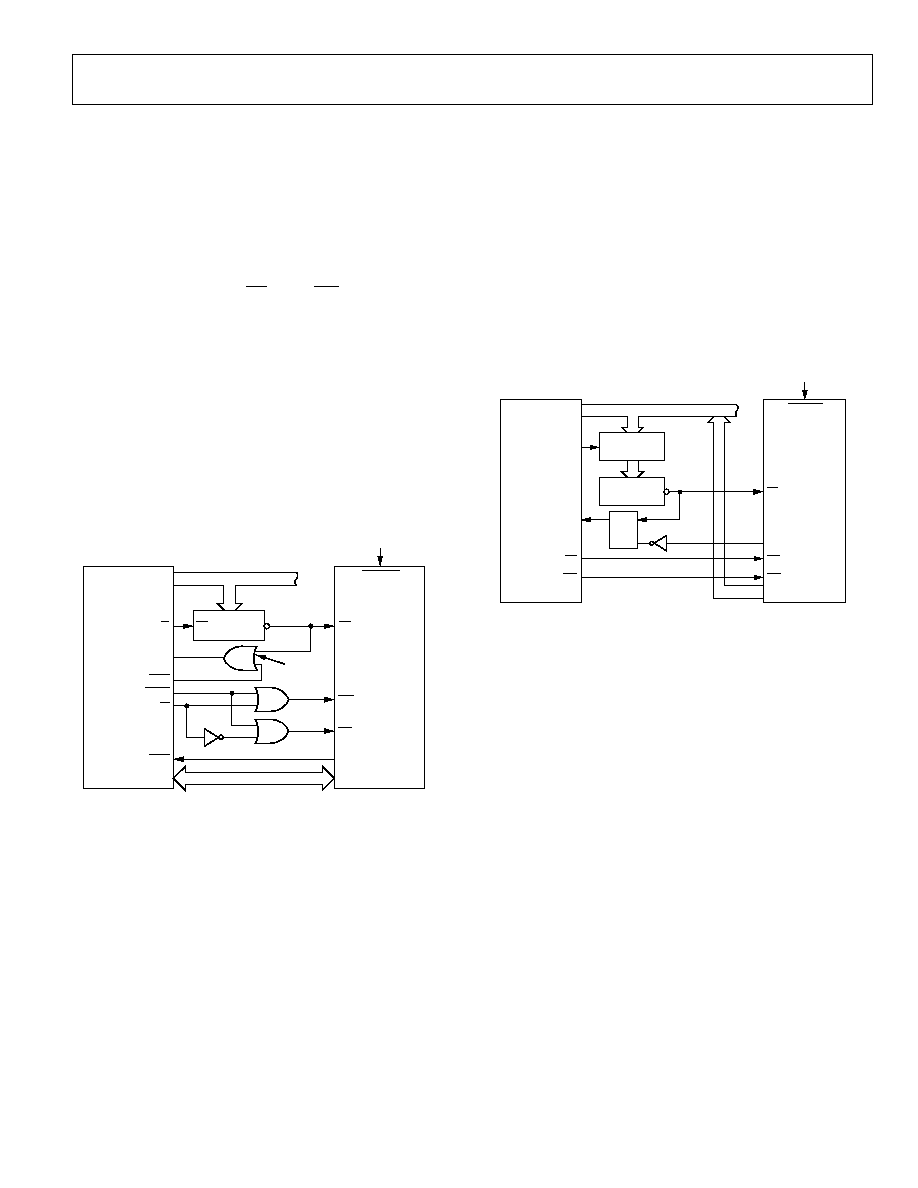
Preliminary Technical Data
AD7933/AD7934
AD7933/AD7934 to TMS32020, TMS320C25, and
TMS320C5x Interface
Parallel interfaces between the AD7933/AD7934 and the
TMS32020, TMS320C25 and TMS320C5x family of DSPs are
shown in
. The memory mapped address chosen for
the AD7933/AD7934 should be chosen to fall in the I/O
memory space of the DSPs. The parallel interface on the
AD7933/AD7934 is fast enough to interface to the TMS32020
with no extra wait states. If high speed glue logic, such as 74AS
devices, are used to drive the RD and the WR lines when
interfacing to the TMS320C25, then again, no wait states are
necessary. However, if slower logic is used, data accesses may be
slowed sufficiently when reading from and writing to the part to
require the insertion of one wait state. Extra wait states will be
necessary when using the TMS320C5x at their fastest clock
speeds (see the TMS320C5x User's Guide for details).
Figure 46
Figure 46. Interfacing to the TMS32020/C25/C5x
Data is read from the ADC using the following instruction:
IN
D,
ADC
where D is the data memory address, and ADC is the
AD7933/AD7934 address.
AD7933/
AD7934*
TMS32020/
TMS320C25/
TMS320C50*
WR
RD
DB11 TO DB0
DMD0 TO DMD15
A0 TO A15
IS
READY
INT
X
BUSY
CS
EN
CONVST
OPTIONAL
TMS320C25
ONLY
R/W
STRB
*ADDITIONAL PINS OMITTED FOR CLARITY
ADDRESS BUS
DATA BUS
ADDRESS
DECODER
03713-0-046
MSC
AD7933/AD7934 to 80C186 Interface
Figure 47 shows the AD7933/AD7934 interfaced to the 80C186
microprocessor. The 80C186 DMA controller provides two
independent high speed DMA channels where data transfer can
occur between memory and I/O spaces. Each data transfer
consumes two bus cycles, one cycle to fetch data and the other
to store data. After the AD7933/AD7934 has finished a
conversion, the BUSY line generates a DMA request to
Channel 1 (DRQ1). As a result of the interrupt, the processor
performs a DMA READ operation which also resets the
interrupt latch. Sufficient priority must be assigned to the DMA
channel to ensure that the DMA request will be serviced before
the completion of the next conversion.
AD7933/
AD7934*
80C186*
WR
DB0 TO DB11
AD0 TO AD15
A16 TO A19
ALE
DRQ1
BUSY
CS
Q R
S
CONVST
OPTIONAL
WR
RD
RD
*ADDITIONAL PINS OMITTED FOR CLARITY
ADDRESS/DATA BUS
ADDRESS BUS
DATA BUS
ADDRESS
LATCH
ADDRESS
DECODER
03713-
0-
047
Figure 47. Interfacing to the 80C186
Rev. PrG | Page 29 of 32

AD7933/AD7934
Preliminary Technical Data
APPLICATION HINTS
GROUNDING AND LAYOUT
The printed circuit board that houses the AD7933/AD7934
should be designed so that the analog and digital sections are
separated and confined to certain areas of the board. This
facilitates the use of ground planes that can be easily separated.
A minimum etch technique is generally best for ground planes
as it gives the best shielding. Digital and analog ground planes
should be joined in only one place, and the connection should
be a star ground point established as close to the ground pins on
the AD7933/AD7934 as possible. Avoid running digital lines
under the device as this couples noise onto the die. The analog
ground plane should be allowed to run under the
AD7933/AD7934 to avoid noise coupling. The power supply
lines to the AD7933/AD7934 should use as large a trace as
possible to provide low impedance paths and reduce the effects
of glitches on the power supply line.
Fast switching signals, such as clocks, should be shielded with
digital ground to avoid radiating noise to other sections of the
board, and clock signals should never run near the analog
inputs. Avoid crossover of digital and analog signals. Traces on
opposite sides of the board should run at right angles to each
other. This reduces the effects of feedthrough through the
board. A microstrip technique is by far the best but is not always
possible with a double-sided board.
In this technique, the component side of the board is dedicated
to ground planes, while signals are placed on the solder side.
Good decoupling is also important. All analog supplies should
be decoupled with 10 µF tantalum capacitors in parallel with
0.1 µF capacitors to GND. To achieve the best from these
decoupling components, they must be placed as close as
possible to the device.
EVALUATING THE AD7933/AD7934
PERFORMANCE
The recommended layout for the AD7933/AD7934 is outlined
in the evaluation board documentation. The evaluation board
package includes a fully assembled and tested evaluation board,
documentation, and software for controlling the board from the
PC via the evaluation board controller. The evaluation board
controller can be used in conjunction with the
AD7933/AD7934 evaluation board, as well as many other ADI
evaluation boards ending in the CB designator, to
demonstrate/evaluate the ac and dc performance of the
AD7933/AD7934.
The software allows the user to perform ac (fast Fourier
transform) and dc (histogram of codes) tests on the
AD7933/AD7934. The software and documentation are on the
CD that ships with the evaluation board.
Rev. PrG | Page 30 of 32
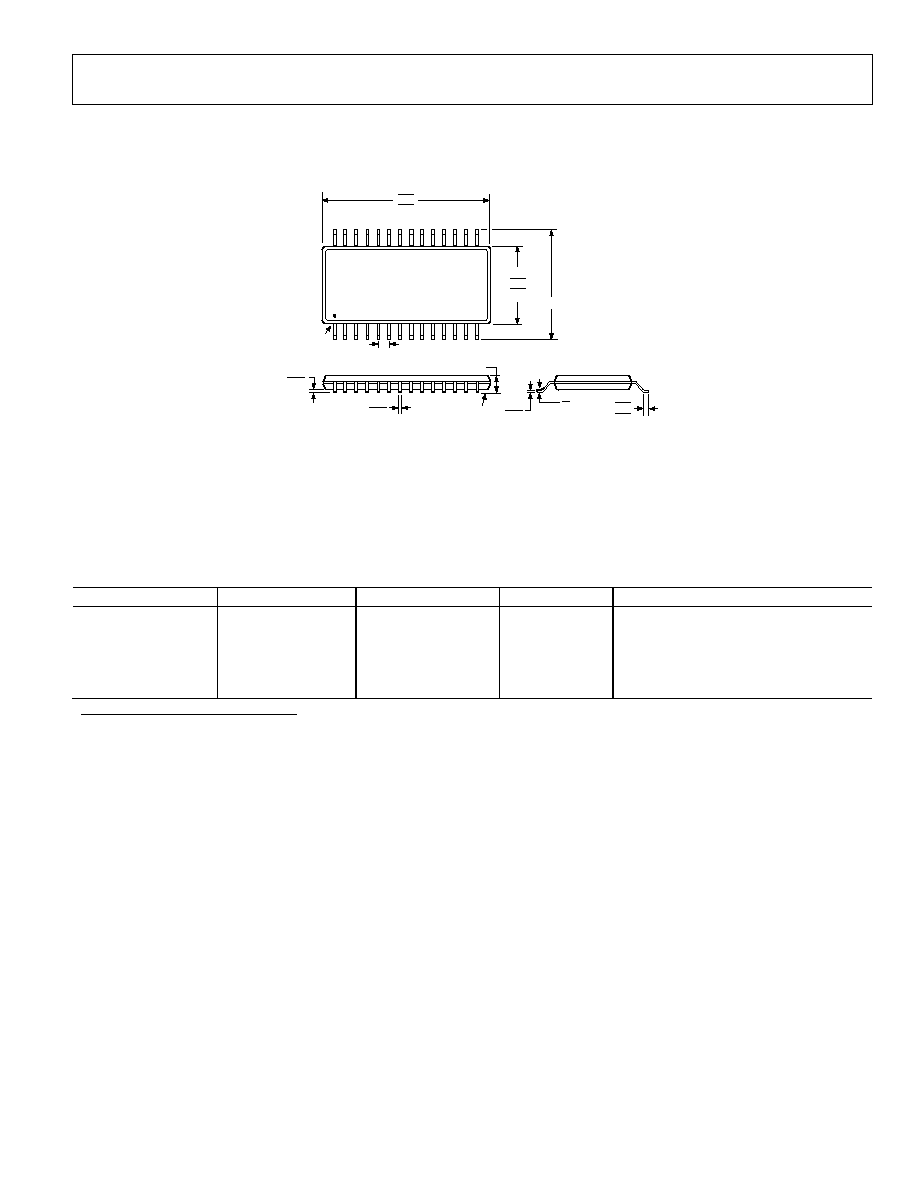
Preliminary Technical Data
AD7933/AD7934
OUTLINE DIMENSIONS
2 8
1 5
1 4
1
8 °
0 °
COMPLIANT TO JEDEC STANDARDS MO-153AE
SEATING
PLANE
COPLANARITY
0.10
1.20 MAX
6.40 BSC
0.65
BSC
PIN 1
0.30
0.19
0.20
0.09
4.50
4.40
4.30
0.75
0.60
0.45
9.80
9.70
9.60
0.15
0.05
Figure 48. 28-Lead Thin Shrink Small Outline Package [TSSOP]
(RU-28)
Dimensions shown in millimeters
ORDERING GUIDE
Model
Temperature Range
Linearity Error (LSB)
1
Package Option
Package Descriptions
AD7934BRU
-40°C to +85°C
±1
RU-28
Thin Shrink Small Outline Package (TSSOP)
AD7933BRU
-40°C to +85°C
±1
RU-28
Thin Shrink Small Outline Package (TSSOP)
EVAL-AD7934CB
2
Evaluation
Board
EVAL-AD7933CB
3
Evaluation
Board
EVAL-CONTROL BRD2
4
Controller
Board
1
Linearity error here refers to integral linearity error.
2
This can be used as a standalone evaluation board or in conjunction with the Evaluation Board Controller for evaluation/demonstration purposes.
3
This can be used as a standalone evaluation board or in conjunction with the Evaluation Board Controller for evaluation/demonstration purposes.
4
Evaluation Board Controller. This board is a complete unit allowing a PC to control and communicate with all Analog Devices evaluation boards ending in the CB
designators. The following needs to be ordered to obtain a complete evaluation kit: the ADC Evaluation Board (EVAL-AD7934CB), the EVAL-CONTROL BRD2, and a 12 V
ac transformer. See the EVAL-AD7933/34CB evaluation board technical note for more details.
Rev. PrG | Page 31 of 32

AD7933/AD7934
Preliminary Technical Data
NOTES
© 2004 Analog Devices, Inc. All rights reserved. Trademarks and
registered trademarks are the property of their respective owners.
Rev. PrG | Page 32 of 32
PR03713-0-8/04(PrG)
Document Outline































